OCA/OCP Java SE 7 Programmer I & II Study Guide (Exams 1Z0-803 & 1Z0-804) (2015)
Part 2. OCP
Chapter 13. Threads
CERTIFICATION OBJECTIVES
• Create and Use the Thread Class and the Runnable Interface
• Manage and Control the Thread Lifecycle
• Synchronize Thread Access to Shared Data
• Identify Code that May Not Execute Correctly in a Multithreaded Environment
![]() Two-Minute Drill
Two-Minute Drill
Q&A Self Test
CERTIFICATION OBJECTIVES
Defining, Instantiating, and Starting Threads (OCP Objective 10.1)
10.1 Create and use the Thread class and the Runnable interface.
Imagine a stockbroker application with a lot of complex capabilities. One of its functions is “download last stock option prices,” another is “check prices for warnings,” and a third time-consuming operation is “analyze historical data for company XYZ.”
In a single-threaded runtime environment, these actions execute one after another. The next action can happen only when the previous one is finished. If a historical analysis takes half an hour, and the user selects to perform a download and check afterward, the warning may come too late to, say, buy or sell stock as a result.
We just imagined the sort of application that cries out for multithreading. Ideally, the download should happen in the background (that is, in another thread). That way, other processes could happen at the same time so that, for example, a warning could be communicated instantly. All the while, the user is interacting with other parts of the application. The analysis, too, could happen in a separate thread so the user can work in the rest of the application while the results are being calculated.
So what exactly is a thread? In Java, “thread” means two different things:
![]() An instance of class java.lang.Thread
An instance of class java.lang.Thread
![]() A thread of execution
A thread of execution
An instance of Thread is just… an object. Like any other object in Java, it has variables and methods, and lives and dies on the heap. But a thread of executionis an individual process (a “lightweight” process) that has its own call stack. In Java, there is one thread per call stack—or, to think of it in reverse, one call stack per thread. Even if you don’t create any new threads in your program, threads are back there running.
The main() method, which starts the whole ball rolling, runs in one thread, called (surprisingly) the main thread. If you looked at the main call stack (and you can, any time you get a stack trace from something that happens after main begins, but not within another thread), you’d see that main() is the first method on the stack—the method at the bottom. But as soon as you create a new thread, a new stack materializes and methods called from that thread run in a call stack that’s separate from the main() call stack. That second new call stack is said to run concurrently with the main thread, but we’ll refine that notion as we go through this chapter.
You might find it confusing that we’re talking about code running concurrently—what gives? The JVM, which gets its turn at the CPU by whatever scheduling mechanism the underlying OS uses, operates like a mini-OS and schedules its own threads, regardless of the underlying operating system. In some JVMs, the Java threads are actually mapped to native OS threads, but we won’t discuss that here; native threads are not on the exam. Nor is it required to understand how threads behave in different JVM environments. In fact, the most important concept to understand from this entire chapter is this:
When it comes to threads, very little is guaranteed.
So be very cautious about interpreting the behavior you see on one machine as “the way threads work.” The exam expects you to know what is and is not guaranteed behavior so that you can design your program in such a way that it will work, regardless of the underlying JVM.That’s part of the whole point of Java.

Don’t make the mistake of designing your program to be dependent on a particular implementation of the JVM. As you’ll learn a little later, different JVMs can run threads in profoundly different ways. For example, one JVM might be sure that all threads get their turn, with a fairly even amount of time allocated for each thread in a nice, happy, round-robin fashion. But in other JVMs, a thread might start running and then just hog the whole show, never stepping out so others can have a turn. If you test your application on the “nice turn-taking” JVM and you don’t know what is and is not guaranteed in Java, then you might be in for a big shock when you run it under a JVM with a different thread-scheduling mechanism.
The thread questions are among the most difficult questions on the exam. In fact, for most people, they are the toughest questions on the exam, and with four objectives for threads, you’ll be answering a lot of thread questions. If you’re not already familiar with threads, you’ll probably need to spend some time experimenting. Also, one final disclaimer: This chapter makes almost no attempt to teach you how to design a good, safe, multithreaded application. We only scratch the surface of that huge topic in this chapter! You’re here to learn the basics of threading and what you need to get through the thread questions on the exam. Before you can write decent multithreaded code, however, you really need to do more study of the complexities and subtleties of multithreaded code.
(Note: The topic of daemon threads is NOT on the exam. All of the threads discussed in this chapter are “user” threads. You and the operating system can create a second kind of thread called a daemon thread. The difference between these two types of threads [user and daemon] is that the JVM exits an application only when all user threads are complete—the JVM doesn’t care about letting daemon threads complete, so once all user threads are complete, the JVM will shut down, regardless of the state of any daemon threads. Once again, this topic is NOT on the exam.)
Making a Thread
A thread in Java begins as an instance of java.lang.Thread. You’ll find methods in the Thread class for managing threads, including creating, starting, and pausing them. For the exam, you’ll need to know, at a minimum, the following methods:

The action happens in the run() method. Think of the code you want to execute in a separate thread as the job to do. In other words, you have some work that needs to be done—say, downloading stock prices in the background while other things are happening in the program—so what you really want is that job to be executed in its own thread. So if the work you want done is the job, the one doing the work (actually executing the job code) is the thread. And the job always starts from a run() method, as follows:

You always write the code that needs to be run in a separate thread in a run() method. The run() method will call other methods, of course, but the thread of execution—the new call stack—always begins by invoking run(). So where does the run() method go? In one of the two classes you can use to define your thread job.
You can define and instantiate a thread in one of two ways:
![]() Extend the java.lang.Thread class.
Extend the java.lang.Thread class.
![]() Implement the Runnable interface.
Implement the Runnable interface.
You need to know about both for the exam, although in the real world, you’re much more likely to implement Runnable than extend Thread. Extending the Thread class is the easiest, but it’s usually not a good OO practice. Why? Because subclassing should be reserved for specialized versions of more general superclasses. So the only time it really makes sense (from an OO perspective) to extend Thread is when you have a more specialized version of a Thread class. In other words, because you have more specialized thread-specific behavior. Chances are, though, that the thread work you want is really just a job to be done by a thread. In that case, you should design a class that implements the Runnable interface, which also leaves your class free to extend some other class.
Defining a Thread
To define a thread, you need a place to put your run() method, and as we just discussed, you can do that by extending the Thread class or by implementing the Runnable interface. We’ll look at both in this section.
Extending java.lang.Thread
The simplest way to define code to run in a separate thread is to
![]() Extend the java.lang.Thread class.
Extend the java.lang.Thread class.
![]() Override the run() method.
Override the run() method.
It looks like this:

The limitation with this approach (besides being a poor design choice in most cases) is that if you extend Thread, you can’t extend anything else. And it’s not as if you really need that inherited Thread class behavior, because in order to use a thread, you’ll need to instantiate one anyway.
Keep in mind that you’re free to overload the run() method in your Thread subclass:

But know this: The overloaded run(String s) method will be ignored by the Thread class unless you call it yourself. The Thread class expects a run() method with no arguments, and it will execute this method for you in a separate call stack after the thread has been started. With arun(String s) method, the Thread class won’t call the method for you, and even if you call the method directly yourself, execution won’t happen in a new thread of execution with a separate call stack. It will just happen in the same call stack as the code that you made the call from, just like any other normal method call.
Implementing java.lang.Runnable
Implementing the Runnable interface gives you a way to extend any class you like but still define behavior that will be run by a separate thread. It looks like this:

Regardless of which mechanism you choose, you’ve now got yourself some code that can be run by a thread of execution. So now let’s take a look at instantiating your thread-capable class, and then we’ll figure out how to actually get the thing running.
Instantiating a Thread
Remember, every thread of execution begins as an instance of class Thread. Regardless of whether your run() method is in a Thread subclass or a Runnable implementation class, you still need a Thread object to do the work.
If you extended the Thread class, instantiation is dead simple (we’ll look at some additional overloaded constructors in a moment):
![]()
If you implement Runnable, instantiation is only slightly less simple. To have code run by a separate thread, you still need a Thread instance.But rather than combining both the thread and the job (the code in the run() method) into one class, you’ve split it into two classes—theThread class for the thread-specificcode and your Runnable implementation class for your job-that-should-be-run-by-a-threadcode. (Another common way to think about this is that the Thread is the “worker,” and the Runnable is the “job” to be done.)
First, you instantiate your Runnable class:
![]()
Next, you get yourself an instance of java.lang.Thread (somebodyhas to run your job…), and you give it your job!
![]()
If you create a thread using the no-arg constructor, the thread will call its own run() method when it’s time to start working. That’s exactly what you want when you extend Thread, but when you use Runnable, you need to tell the new thread to use your run() method rather than its own. The Runnable you pass to the Thread constructor is called the targetor the target Runnable.
You can pass a single Runnable instance to multiple Thread objects so that the same Runnable becomes the target of multiple threads, as follows:

Giving the same target to multiple threads means that several threads of execution will be running the very same job (and that the same job will be done multiple times).

The Thread class itself implements Runnable. (After all, it has a run() method that we were overriding.) This means that you could pass a Thread to another Thread’s constructor:
Thread t = new Thread(new MyThread());
This is a bit silly, but it’s legal. In this case, you really just need a Runnnable, and creating a whole other Thread is overkill.
Besides the no-arg constructor and the constructor that takes a Runnable (the target, i.e., the instance with the job to do), there are other overloaded constructors in class Thread. The constructors we care about are
![]() Thread()
Thread()
![]() Thread(Runnable target)
Thread(Runnable target)
![]() Thread(Runnable target, String name)
Thread(Runnable target, String name)
![]() Thread(String name)
Thread(String name)
You need to recognize all of them for the exam! A little later, we’ll discuss some of the other constructors in the preceding list.
So now you’ve made yourself a Thread instance, and it knows which run() method to call. But nothing is happening yet. At this point, all we’ve got is a plain old Java object of type Thread. It is not yet a thread of execution. To get an actual thread—a new call stack—we still have to start the thread.
When a thread has been instantiated but not started (in other words, the start() method has not been invoked on the Thread instance), the thread is said to be in the new state. At this stage, the thread is not yet considered alive. Once the start() method is called, the thread is considered alive (even though the run() method may not have actually started executing yet). A thread is considered dead (no longer alive) after the run() method completes. The isAlive() method is the best way to determine if a thread has been started but has not yet completed itsrun() method. (Note: The getState() method is very useful for debugging, but you won’t have to know it for the exam.)
Starting a Thread
You’ve created a Thread object and it knows its target (either the passed-in Runnable or itself if you extended class Thread). Now it’s time to get the whole thread thing happening—to launch a new call stack. It’s so simple, it hardly deserves its own subheading:
![]()
Prior to calling start() on a Thread instance, the thread (when we use lowercase t, we’re referring to the thread of executionrather than the Thread class) is said to be in the newstate, as we said. The new state means you have a Thread object but you don’t yet have a true thread. So what happens after you call start()? The good stuff:
![]() A new thread of execution starts (with a new call stack).
A new thread of execution starts (with a new call stack).
![]() The thread moves from the newstate to the runnablestate.
The thread moves from the newstate to the runnablestate.
![]() When the thread gets a chance to execute, its target run() method will run.
When the thread gets a chance to execute, its target run() method will run.
Be sureyou remember the following: You start a Thread, not a Runnable. You call start() on a Thread instance, not on a Runnable instance. The following example demonstrates what we’ve covered so far—defining, instantiating, and starting a thread:
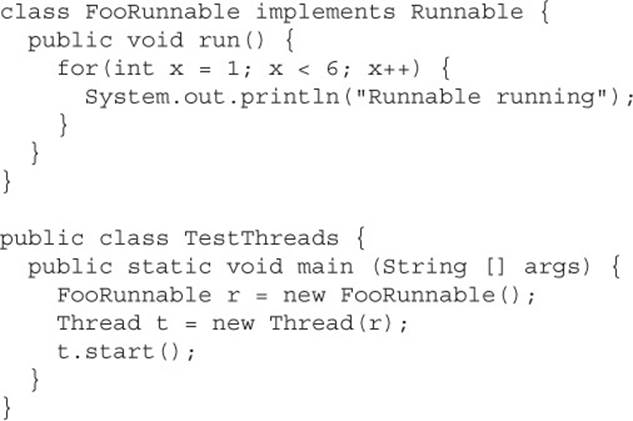
Running the preceding code prints out exactly what you’d expect:
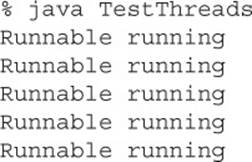
(If this isn’t what you expected, go back and reread everything in this objective.)

There’s nothing special about the run() method as far as Java is concerned. Like main(), it just happens to be the name (and signature) of the method that the new thread knows to invoke. So if you see code that calls the run() method on a Runnable (or even on a Thread instance), that’s perfectly legal. But it doesn’t mean the run() method will run in a separate thread! Calling a run() method directly just means you’re invoking a method from whatever thread is currently executing, and the run() method goes onto the current call stack rather than at the beginning of a new call stack. The following code does not start a new thread of execution:
![]()
So what happens if we start multiple threads? We’ll run a simple example in a moment, but first we need to know how to print out which thread is executing. We can use the getName() method of class Thread and have each Runnable print out the name of the thread executing thatRunnable object’s run() method. The following example instantiates a thread and gives it a name, and then the name is printed out from the run() method:

Running this code produces the following extra-special output:

To get the name of a thread, you call—who would have guessed—getName() on the Thread instance. But the target Runnable instance doesn’t even have a reference to the Thread instance, so we first invoked the static Thread.currentThread() method, which returns a reference to the currently executing thread, and then we invoked getName() on that returned reference.
Even if you don’t explicitly name a thread, it still has a name. Let’s look at the previous code, commenting out the statement that sets the thread’s name:
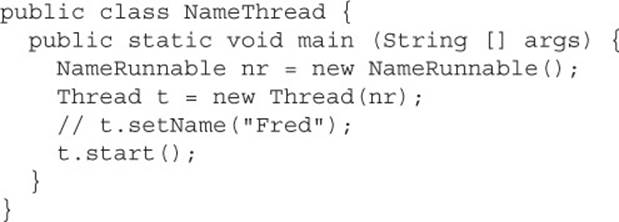
Running the preceding code now gives us

And since we’re getting the name of the current thread by using the static Thread.currentThread() method, we can even get the name of the thread running our main code:

which prints out
![]()
That’s right, the main thread already has a name—main. (Once again, what are the odds?) Figure 13-1 shows the process of starting a thread.
FIGURE 13-1 Starting a thread

Starting and Running Multiple Threads
Enough playing around here; let’s actually get multiple threads going (more than two, that is). We already had two threads, because the main() method starts in a thread of its own, and then t.start() started a second thread. Now we’ll do more. The following code creates a singleRunnable instance and three Thread instances. All three Thread instances get the same Runnable instance, and each thread is given a unique name. Finally, all three threads are started by invoking start() on the Thread instances.

Running this code might produce the following:
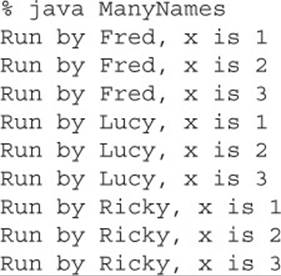
Well, at least that’s what it printed when we ran it—this time, on our machine. But the behavior you see here is not guaranteed. This is so crucial that you need to stop right now, take a deep breath, and repeat after me, “The behavior is not guaranteed.” You need to know, for your future as a Java programmer as well as for the exam, that there is nothing in the Java specification that says threads will start running in the order in which they were started (in other words, the order in which start() was invoked on each thread). And there is no guarantee that once a thread starts executing, it will keep executing until it’s done. Or that a loop will complete before another thread begins. No siree, Bob.
Nothing is guaranteed in the preceding code except this:
Each thread will start, and each thread will run to completion.
Within each thread, things will happen in a predictable order. But the actions of different threads can mix in unpredictable ways. If you run the program multiple times or on multiple machines, you may see different output. Even if you don’t see different output, you need to realize that the behavior you see is not guaranteed. Sometimes a little change in the way the program is run will cause a difference to emerge. Just for fun we bumped up the loop code so that each run() method ran the for loop 400 times rather than 3, and eventually we did start to see some wobbling:
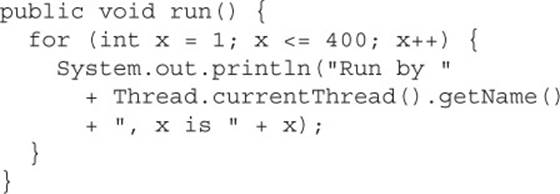
Running the preceding code, with each thread executing its run loop 400 times, started out fine but then became nonlinear. Here’s just a snippet from the command-line output of running that code. To make it easier to distinguish each thread, we put Fred’s output in italics and Lucy’s in bold, and left Ricky’s alone:
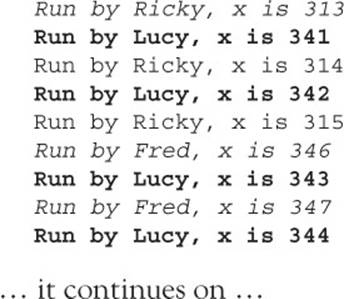
Notice that there’s not really any clear pattern here. If we look at only the output from Fred, we see the numbers increasing one at a time, as expected:

And similarly, if we look only at the output from Lucy or Ricky—each one individually is behaving in a nice, orderly manner. But together—chaos! In the previous fragment we see Fred, then Lucy, then Ricky (in the same order we originally started the threads), but then Lucy butts in when it was Fred’s turn. What nerve! And then Ricky and Lucy trade back and forth for a while until finally Fred gets another chance. They jump around like this for a while after this. Eventually (after the part shown earlier), Fred finishes, then Ricky, and finally Lucy finishes with a long sequence of output. So even though Ricky was started third, he actually completed second. And if we run it again, we’ll get a different result. Why? Because it’s up to the scheduler, and we don’t control the scheduler! Which brings up another key point to remember: Just because a series of threads are started in a particular order, this doesn’t mean they’ll run in that order. For any group of started threads, order is not guaranteed by the scheduler. And duration is not guaranteed. You don’t know, for example, if one thread will run to completion before the others have a chance to get in, or whether they’ll all take turns nicely, or whether they’ll do a combination of both. There is a way, however, to start a thread but tell it not to run until some other thread has finished. You can do this with the join() method, which we’ll look at a little later.
A thread is done being a thread when its target run() method completes.
When a thread completes its run() method, the thread ceases to be a thread of execution. The stack for that thread dissolves, and the thread is considered dead. (Technically, the API calls a dead thread “terminated,” but we’ll use “dead” in this chapter.) Not dead and gone, however—just dead. It’s still a Thread object, just not a thread of execution. So if you’ve got a reference to a Thread instance, then even when that Thread instance is no longer a thread of execution, you can still call methods on the Thread instance, just like any other Java object. What you can’t do, though, is call start() again.
Once a thread has been started, it can never be started again.
If you have a reference to a Thread and you call start(), it’s started. If you call start() a second time, it will cause an exception (an IllegalThreadStateException, which is a kind of RuntimeException, but you don’t need to worry about the exact type). This happens whether or not the run() method has completed from the first start() call. Only a new thread can be started, and then only once. A runnable thread or a dead thread cannot be restarted.
So far, we’ve seen three thread states: new, runnable, and dead. We’ll look at more thread states before we’re done with this chapter.

In addition to using setName() and getName to identify threads, you might see getId(). The getId() method returns a positive, unique, long number, and that number will be that thread’s only ID number for the thread’s entire life.
The Thread Scheduler
The thread scheduler is the part of the JVM (although most JVMs map Java threads directly to native threads on the underlying OS) that decides which thread should run at any given moment, and also takes threads out of the run state. Assuming a single processor machine, only one thread can actually run at a time. Only one stack can ever be executing at one time. And it’s the thread scheduler that decides which thread—of all that are eligible—will actually run. When we say eligible, we really mean in the runnable state.
Any thread in the runnable state can be chosen by the scheduler to be the one and only running thread. If a thread is not in a runnable state, then it cannot be chosen to be the currently runningthread. And just so we’re clear about how little is guaranteed here:
The order in which runnable threads are chosen to run is not guaranteed.
Although queue behavior is typical, it isn’t guaranteed. Queue behavior means that when a thread has finished with its “turn,” it moves to the end of the line of the runnable pool and waits until it eventually gets to the front of the line, where it can be chosen again. In fact, we call it a runnable pool, rather than a runnable queue, to help reinforce the fact that threads aren’t all lined up in some guaranteed order.
Although we don’t control the thread scheduler (we can’t, for example, tell a specific thread to run), we can sometimes influence it. The following methods give us some tools for influencing the scheduler. Just don’t ever mistake influence for control.

Expect to see exam questions that look for your understanding of what is and is not guaranteed! You must be able to look at thread code and determine whether the output is guaranteed to run in a particular way or is indeterminate.
from the java.lang.Thread Class Some of the methods that can help us influence thread scheduling are as follows:

Note that both sleep() and join() have overloaded versions not shown here.
Methods from the java.lang.Object Class Every class in Java inherits the following three thread-related methods:

The wait() method has three overloaded versions (including the one listed here).
We’ll look at the behavior of each of these methods in this chapter. First, though, we’re going to look at the different states a thread can be in.
CERTIFICATION OBJECTIVES
Thread States and Transitions (OCP Objective 10.2)
10.2 Manage and control thread lifecycle.
We’ve already seen three thread states—new, runnable, and dead—but wait! There’s more! The thread scheduler’s job is to move threads in and out of the running state. While the thread scheduler can move a thread from the running state back to runnable, other factors can cause a thread to move out of running, but not back to runnable. One of these is when the thread’s run() method completes, in which case, the thread moves from the running state directly to the dead state. Next, we’ll look at some of the other ways in which a thread can leave the running state and where the thread goes.
Thread States
A thread can be only in one of five states (see Figure 13-2):
FIGURE 13-2 Transitioning between thread states
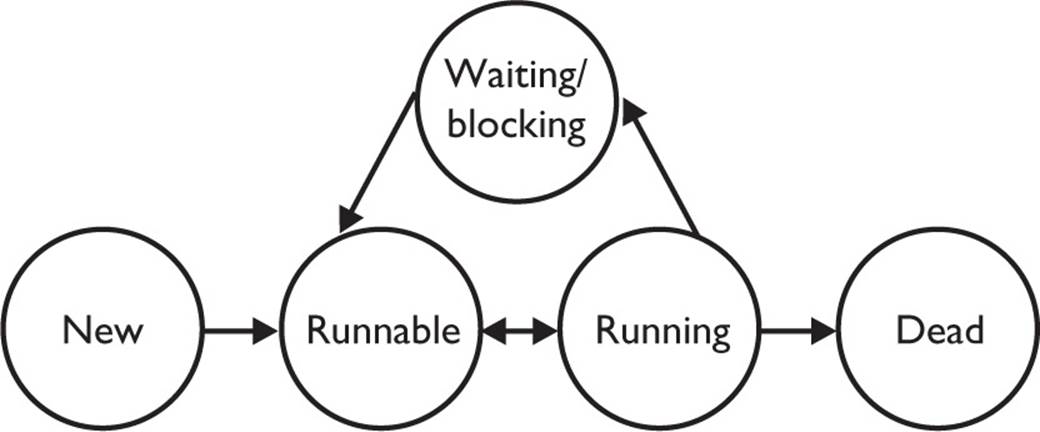
![]() New This is the state the thread is in after the Thread instance has been created but the start() method has not been invoked on the thread. It is a live Thread object, but not yet a thread of execution. At this point, the thread is considered not alive.
New This is the state the thread is in after the Thread instance has been created but the start() method has not been invoked on the thread. It is a live Thread object, but not yet a thread of execution. At this point, the thread is considered not alive.
![]() Runnable This is the state a thread is in when it’s eligible to run but the scheduler has not selected it to be the running thread. A thread first enters the runnable state when the start() method is invoked, but a thread can also return to the runnable state after either running or coming back from a blocked, waiting, or sleeping state. When the thread is in the runnable state, it is considered alive.
Runnable This is the state a thread is in when it’s eligible to run but the scheduler has not selected it to be the running thread. A thread first enters the runnable state when the start() method is invoked, but a thread can also return to the runnable state after either running or coming back from a blocked, waiting, or sleeping state. When the thread is in the runnable state, it is considered alive.
![]() Running This is it. The “big time.” Where the action is. This is the state a thread is in when the thread scheduler selects it from the runnable pool to be the currently executing process. A thread can transition out of a running state for several reasons, including because “the thread scheduler felt like it.” We’ll look at those other reasons shortly. Note that in Figure 13-2, there are several ways to get to the runnable state, but only one way to get to the running state: The scheduler chooses a thread from the runnable pool.
Running This is it. The “big time.” Where the action is. This is the state a thread is in when the thread scheduler selects it from the runnable pool to be the currently executing process. A thread can transition out of a running state for several reasons, including because “the thread scheduler felt like it.” We’ll look at those other reasons shortly. Note that in Figure 13-2, there are several ways to get to the runnable state, but only one way to get to the running state: The scheduler chooses a thread from the runnable pool.
![]() Waiting/blocked/sleeping This is the state a thread is in when it’s not eligible to run. Okay, so this is really three states combined into one, but they all have one thing in common: The thread is still alive, but is currently not eligible to run. In other words, it is not runnable, but it might return to a runnable state later if a particular event occurs. A thread may be blocked waiting for a resource (like I/O or an object’s lock), in which case the event that sends it back to runnable is the availability of the resource—for example, if data comes in through the input stream the thread code is reading from, or if the object’s lock suddenly becomes available. A thread may be sleeping because the thread’s run code tells it to sleep for some period of time, in which case, the event that sends it back to runnable causes it to wake up because its sleep time has expired. Or the thread may be waiting because the thread’s run code causes it to wait, in which case, the event that sends it back to runnable causes another thread to send a notification that it may no longer be necessary for the thread to wait. The important point is that one thread does not tell another thread to block. Some methods may look like they tell another thread to block, but they don’t. If you have a reference t to another thread, you can write something like this:
Waiting/blocked/sleeping This is the state a thread is in when it’s not eligible to run. Okay, so this is really three states combined into one, but they all have one thing in common: The thread is still alive, but is currently not eligible to run. In other words, it is not runnable, but it might return to a runnable state later if a particular event occurs. A thread may be blocked waiting for a resource (like I/O or an object’s lock), in which case the event that sends it back to runnable is the availability of the resource—for example, if data comes in through the input stream the thread code is reading from, or if the object’s lock suddenly becomes available. A thread may be sleeping because the thread’s run code tells it to sleep for some period of time, in which case, the event that sends it back to runnable causes it to wake up because its sleep time has expired. Or the thread may be waiting because the thread’s run code causes it to wait, in which case, the event that sends it back to runnable causes another thread to send a notification that it may no longer be necessary for the thread to wait. The important point is that one thread does not tell another thread to block. Some methods may look like they tell another thread to block, but they don’t. If you have a reference t to another thread, you can write something like this:
t.sleep(); or t.yield();
But those are actually static methods of the Thread class—they don’t affect the instance t; instead, they are defined to always affect the thread that’s currently executing. (This is a good example of why it’s a bad idea to use an instance variable to access a static method—it’s misleading. There is a method, suspend(), in the Thread class that lets one thread tell another to suspend, but the suspend() method has been deprecated and won’t be on the exam [nor will its counterpart resume()].) There is also a stop() method, but it, too, has been deprecated and we won’t even go there. Both suspend() and stop() turned out to be very dangerous, so you shouldn’t use them, and again, because they’re deprecated, they won’t appear on the exam. Don’t study ‘em; don’t use ‘em. Note also that a thread in a blocked state is still considered alive.
![]() Dead A thread is considered dead when its run() method completes. It may still be a viable Thread object, but it is no longer a separate thread of execution. Once a thread is dead, it can never be brought back to life! (The whole “I see dead threads” thing.) If you invoke start()on a dead Thread instance, you’ll get a runtime (not compiler) exception. And it probably doesn’t take a rocket scientist to tell you that if a thread is dead, it is no longer considered alive.
Dead A thread is considered dead when its run() method completes. It may still be a viable Thread object, but it is no longer a separate thread of execution. Once a thread is dead, it can never be brought back to life! (The whole “I see dead threads” thing.) If you invoke start()on a dead Thread instance, you’ll get a runtime (not compiler) exception. And it probably doesn’t take a rocket scientist to tell you that if a thread is dead, it is no longer considered alive.
Preventing Thread Execution
A thread that’s been stopped usually means a thread that’s moved to the dead state. But Objective 4.2 is also looking for your ability to recognize when a thread will get kicked out of running but not be sent back to either runnable or dead.
For the purpose of the exam, we aren’t concerned with a thread blocking on I/O (say, waiting for something to arrive from an input stream from the server). We are concerned with the following:
![]() Sleeping
Sleeping
![]() Waiting
Waiting
![]() Blocked because it needs an object’s lock
Blocked because it needs an object’s lock
Sleeping
The sleep() method is a static method of class Thread. You use it in your code to “slow a thread down” by forcing it to go into a sleep mode before coming back to runnable (where it still has to beg to be the currently running thread). When a thread sleeps, it drifts off somewhere and doesn’t return to runnable until it wakes up.
So why would you want a thread to sleep? Well, you might think the thread is moving too quickly through its code. Or you might need to force your threads to take turns, since reasonable turn taking isn’t guaranteed in the Java specification. Or imagine a thread that runs in a loop, downloading the latest stock prices and analyzing them. Downloading prices one after another would be a waste of time, as most would be quite similar—and even more important, it would be an incredible waste of precious bandwidth. The simplest way to solve this is to cause a thread to pause (sleep) for five minutes after each download.
You do this by invoking the static Thread.sleep() method, giving it a time in milliseconds as follows:

Notice that the sleep() method can throw a checked InterruptedException (you’ll usually know if that is a possibility, since another thread has to explicitly do the interrupting), so you must acknowledge the exception with a handle or declare. Typically, you wrap calls to sleep() in a try/catch, as in the preceding code.
Let’s modify our Fred, Lucy, Ricky code by using sleep() to try to force the threads to alternate rather than letting one thread dominate for any period of time. Where do you think the sleep() method should go?
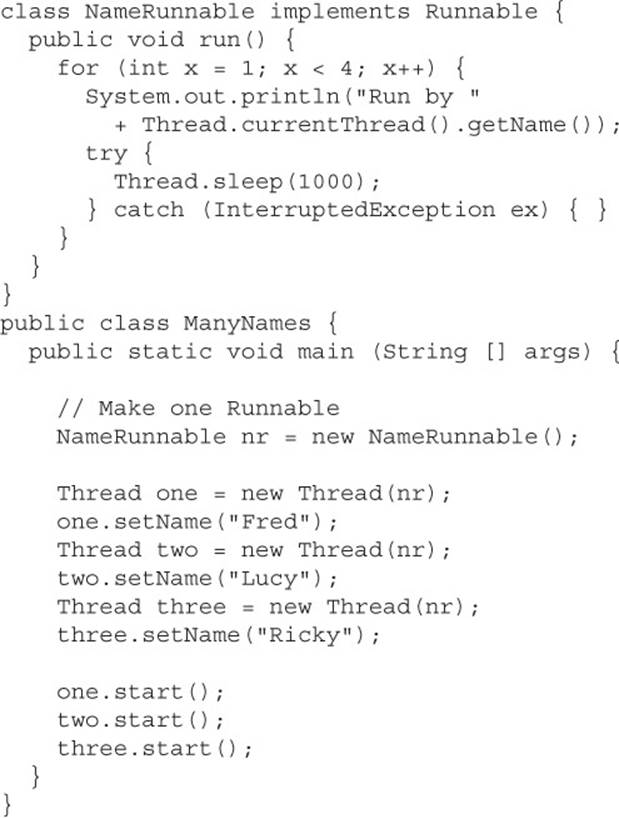
Running this code shows Fred, Lucy, and Ricky alternating nicely:

Just keep in mind that the behavior in the preceding output is still not guaranteed. You can’t be certain how long a thread will actually run before it gets put to sleep, so you can’t know with certainty that only one of the three threads will be in the runnable state when the running thread goes to sleep. In other words, if two threads are awake and in the runnable pool, you can’t know with certainty that the least recently used thread will be the one selected to run. Still, using sleep() is the best way to help all threads get a chance to run!Or at least to guarantee that one thread doesn’t get in and stay until it’s done. When a thread encounters a sleep call, it must go to sleep for at least the specified number of milliseconds (unless it is interrupted before its wake-up time, in which case, it immediately throws the InterruptedException).

Just because a thread’s sleep() expires and it wakes up, this does not mean it will return to running! Remember, when a thread wakes up, it simply goes back to the runnable state. So the time specified in sleep() is the minimum duration in which the thread won’t run, but it is not the exact duration in which the thread won’t run. So you can’t, for example, rely on the sleep() method to give you a perfectly accurate timer. Although in many applications using sleep() as a timer is certainly good enough, you must know that a sleep() time is not a guarantee that the thread will start running again as soon as the time expires and the thread wakes.
Remember that sleep() is a static method, so don’t be fooled into thinking that one thread can put another thread to sleep. You can put sleep() code anywhere, since all code is being run by some thread. When the executing code (meaning the currently running thread’s code) hits asleep() call, it puts the currently running thread to sleep.
EXERCISE 13-1
Creating a Thread and Putting It to Sleep
In this exercise, we will create a simple counting thread. It will count to 100, pausing one second between each number. Also, in keeping with the counting theme, it will output a string every ten numbers.
1. Create a class and extend the Thread class. As an option, you can implement the Runnable interface.
2. Override the run() method of Thread. This is where the code will go that will output the numbers.
3. Create a for loop that will loop 100 times. Use the modulus operation to check whether there are any remainder numbers when divided by 10.
4. Use the static method Thread.sleep() to pause. (Remember, the one-arg version of sleep() specifies the amount of time of sleep in milliseconds.)
Thread Priorities and yield()
To understand yield(), you must understand the concept of thread priorities. Threads always run with some priority, usually represented as a number between 1 and 10 (although in some cases, the range is less than 10). The scheduler in most JVMs uses preemptive, priority-based scheduling (which implies some sort of time slicing). This does not mean that all JVMs use time slicing. The JVM specification does not require a VM to implement a time-slicing scheduler, where each thread is allocated a fair amount of time and then sent back to runnable to give another thread a chance. Although many JVMs do use time slicing, some may use a scheduler that lets one thread stay running until the thread completes its run() method.
In most JVMs, however, the scheduler does use thread priorities in one important way: If a thread enters the runnable state and it has a higher priority than any of the threads in the pool and a higher priority than the currently running thread, the lower-priority running thread usually will be bumped back to runnable and the highest-priority thread will be chosen to run. In other words, at any given time, the currently running thread usually will not have a priority that is lower than any of the threads in the pool. In most cases, the running thread will be of equal or greater priority than the highest-priority threads in the pool. This is as close to a guarantee about scheduling as you’ll get from the JVM specification, so you must never rely on thread priorities to guarantee the correct behavior of your program.

Don’t rely on thread priorities when designing your multithreaded application. Because thread-scheduling priority behavior is not guaranteed, use thread priorities as a way to improve the efficiency of your program, but just be sure your program doesn’t depend on that behavior for correctness.
What is also not guaranteed is the behavior when threads in the pool are of equal priority or when the currently running thread has the same priority as threads in the pool. All priorities being equal, a JVM implementation of the scheduler is free to do just about anything it likes. That means a scheduler might do one of the following (among other things):
![]() Pick a thread to run, and run it there until it blocks or completes.
Pick a thread to run, and run it there until it blocks or completes.
![]() Time-slice the threads in the pool to give everyone an equal opportunity to run.
Time-slice the threads in the pool to give everyone an equal opportunity to run.
Setting a Thread’s Priority
A thread gets a default priority that is the priority of the thread of execution that creates it.For example, in the code

the thread referenced by t will have the same priority as the main thread, since the main thread is executing the code that creates the MyThread instance.
You can also set a thread’s priority directly by calling the setPriority() method on a Thread instance as follows:

Priorities are set using a positive integer, usually between 1 and 10, and the JVM will never change a thread’s priority. However, values 1 through 10 are not guaranteed. Some JVMs might not recognize ten distinct values. Such a JVM might merge values from 1 to 10 down to maybe values from 1 to 5, so if you have, say, ten threads, each with a different priority, and the current application is running in a JVM that allocates a range of only five priorities, then two or more threads might be mapped to one priority.
Although the default priority is 5, the Thread class has the three following constants (static final variables) that define the range of thread priorities:

The yield() Method
So what does the static Thread.yield() have to do with all this? Not that much, in practice. What yield() is supposed to do is make the currently running thread head back to runnable to allow other threads of the same priority to get their turn. So the intention is to use yield() to promote graceful turn-taking among equal-priority threads. In reality, though, the yield() method isn’t guaranteed to do what it claims, and even if yield() does cause a thread to step out of running and back to runnable, there’s no guarantee the yielding thread won’t just be chosen again over all the others! So while yield() might—and often does—make a running thread give up its slot to another runnable thread of the same priority, there’s no guarantee.
A yield() won’t ever cause a thread to go to the waiting/sleeping/blocking state. At most, a yield() will cause a thread to go from running to runnable, but again, it might have no effect at all.
The join() Method
The non-static join() method of class Thread lets one thread “join onto the end” of another thread. If you have a thread B that can’t do its work until another thread A has completed its work, then you want thread B to “join” thread A. This means that thread B will not become runnable until A has finished (and entered the dead state).

The preceding code takes the currently running thread (if this were in the main() method, then that would be the main thread) and joins it to the end of the thread referenced by t. This blocks the current thread from becoming runnable until after the thread referenced by t is no longer alive. In other words, the code t.join() means “Join me (the current thread) to the end of t, so that t must finish before I (the current thread) can run again.” You can also call one of the overloaded versions of join() that takes a timeout duration so that you’re saying, “wait until thread t is done, but if it takes longer than 5,000 milliseconds, then stop waiting and become runnable anyway.” Figure 13-3 shows the effect of the join() method.
FIGURE 13-3 The join() method
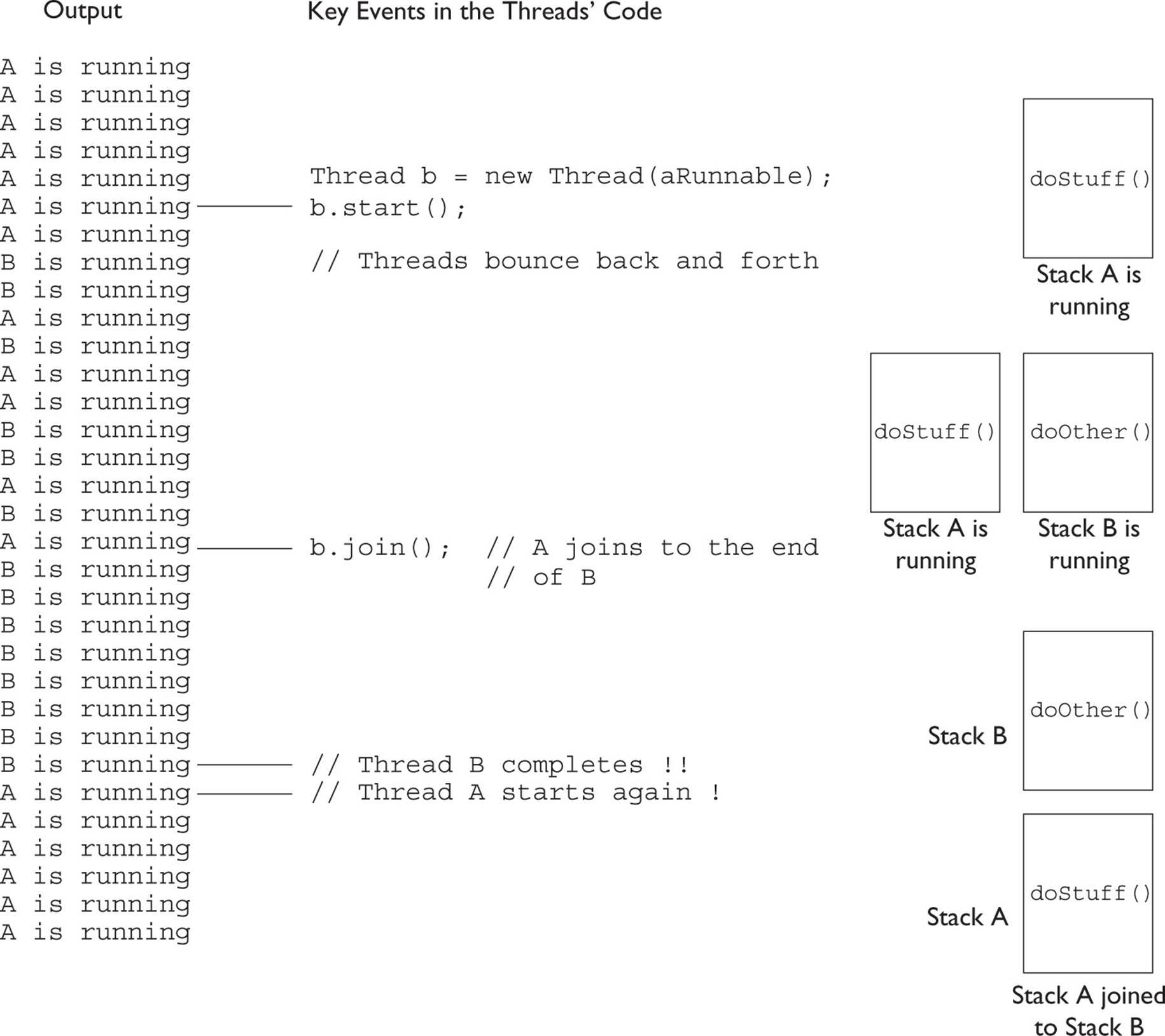
So far, we’ve looked at three ways a running thread could leave the running state:
![]() A call to sleep() Guaranteed to cause the current thread to stop executing for at least the specified sleep duration (although it might be interrupted before its specified time).
A call to sleep() Guaranteed to cause the current thread to stop executing for at least the specified sleep duration (although it might be interrupted before its specified time).
![]() A call to yield() Not guaranteed to do much of anything, although typically, it will cause the currently running thread to move back to runnable so that a thread of the same priority can have a chance.
A call to yield() Not guaranteed to do much of anything, although typically, it will cause the currently running thread to move back to runnable so that a thread of the same priority can have a chance.
![]() A call to join() Guaranteed to cause the current thread to stop executing until the thread it joins with (in other words, the thread it calls join() on) completes, or if the thread it’s trying to join with is not alive, the current thread won’t need to back out.
A call to join() Guaranteed to cause the current thread to stop executing until the thread it joins with (in other words, the thread it calls join() on) completes, or if the thread it’s trying to join with is not alive, the current thread won’t need to back out.
Besides those three, we also have the following scenarios in which a thread might leave the running state:
![]() The thread’s run() method completes. Duh.
The thread’s run() method completes. Duh.
![]() A call to wait() on an object (we don’t call wait() on a thread, as we’ll see in a moment).
A call to wait() on an object (we don’t call wait() on a thread, as we’ll see in a moment).
![]() A thread can’t acquire the lock on the object whose method code it’s attempting to run.
A thread can’t acquire the lock on the object whose method code it’s attempting to run.
![]() The thread scheduler can decide to move the current thread from running to runnable in order to give another thread a chance to run. No reason is needed—the thread scheduler can trade threads in and out whenever it likes.
The thread scheduler can decide to move the current thread from running to runnable in order to give another thread a chance to run. No reason is needed—the thread scheduler can trade threads in and out whenever it likes.
CERTIFICATION OBJECTIVES
Synchronizing Code, Thread Problems (OCP Objectives 10.3 and 10.4)
10.3 Synchronize thread access to shared data.
10.4 Identify potential threading problems.
Can you imagine the havoc that can occur when two different threads have access to a single instance of a class, and both threads invoke methods on that object… and those methods modify the state of the object? In other words, what might happen if two different threads call, say, a setter method on a single object? A scenario like that might corrupt an object’s state by changing its instance variable values in an inconsistent way, and if that object’s state is data shared by other parts of the program, well, it’s too scary to even visualize.
But just because we enjoy horror, let’s look at an example of what might happen. The following code demonstrates what happens when two different threads are accessing the same account data. Imagine that two people each have a checkbook for a single checking account (or two people each have ATM cards, but both cards are linked to only one account).
In this example, we have a class called Account that represents a bank account. To keep the code short, this account starts with a balance of 50 and can be used only for withdrawals. The withdrawal will be accepted even if there isn’t enough money in the account to cover it. The account simply reduces the balance by the amount you want to withdraw:

Now here’s where it starts to get fun. Imagine a couple, Fred and Lucy, who both have access to the account and want to make withdrawals. But they don’t want the account to ever be overdrawn, so just before one of them makes a withdrawal, he or she will first check the balance to be certain there’s enough to cover the withdrawal. Also, withdrawals are always limited to an amount of 10, so there must be at least 10 in the account balance in order to make a withdrawal. Sounds reasonable. But that’s a two-step process:
1. Check the balance.
2. If there’s enough in the account (in this example, at least 10), make the withdrawal.
What happens if something separates step 1 from step 2? For example, imagine what would happen if Lucy checks the balance and sees there’s just exactly enough in the account, 10. But before she makes the withdrawal, Fred checks the balance and also sees that there’s enough for his withdrawal. Since Lucy has verified the balance but not yet made her withdrawal, Fred is seeing “bad data.” He is seeing the account balance before Lucy actually debits the account, but at this point, that debit is certain to occur. Now both Lucy and Fred believe there’s enough to make their withdrawals. So now imagine that Lucy makes her withdrawal, and now there isn’t enough in the account for Fred’s withdrawal, but he thinks there is since when he checked, there was enough! Yikes. In a minute, we’ll see the actual banking code, with Fred and Lucy, represented by two threads, each acting on the same Runnable, and that Runnable holds a reference to the one and only account instance—so, two threads, one account.
The logic in our code example is as follows:
1. The Runnable object holds a reference to a single account.
2. Two threads are started, representing Lucy and Fred, and each thread is given a reference to the same Runnable (which holds a reference to the actual account).
3. The initial balance on the account is 50, and each withdrawal is exactly 10.
4. In the run() method, we loop five times, and in each loop we
![]() Make a withdrawal (if there’s enough in the account).
Make a withdrawal (if there’s enough in the account).
![]() Print a statement if the account is overdrawn (which it should never be since we check the balance before making a withdrawal).
Print a statement if the account is overdrawn (which it should never be since we check the balance before making a withdrawal).
5. The makeWithdrawal() method in the test class (representing the behavior of Fred or Lucy) will do the following:
![]() Check the balance to see if there’s enough for the withdrawal.
Check the balance to see if there’s enough for the withdrawal.
![]() If there is enough, print out the name of the one making the withdrawal.
If there is enough, print out the name of the one making the withdrawal.
![]() Go to sleep for 500 milliseconds—just long enough to give the other partner a chance to get in before you actually make the withdrawal.
Go to sleep for 500 milliseconds—just long enough to give the other partner a chance to get in before you actually make the withdrawal.
![]() Upon waking up, complete the withdrawal and print that fact.
Upon waking up, complete the withdrawal and print that fact.
![]() If there wasn’t enough in the first place, print a statement showing who you are and the fact that there wasn’t enough.
If there wasn’t enough in the first place, print a statement showing who you are and the fact that there wasn’t enough.
So what we’re really trying to discover is if the following is possible: for one partner to check the account and see that there’s enough, but before making the actual withdrawal, the other partner checks the account and also sees that there’s enough. When the account balance gets to 10, if both partners check it before making the withdrawal, both will think it’s okay to withdraw, and the account will overdraw by 10!
Here’s the code:
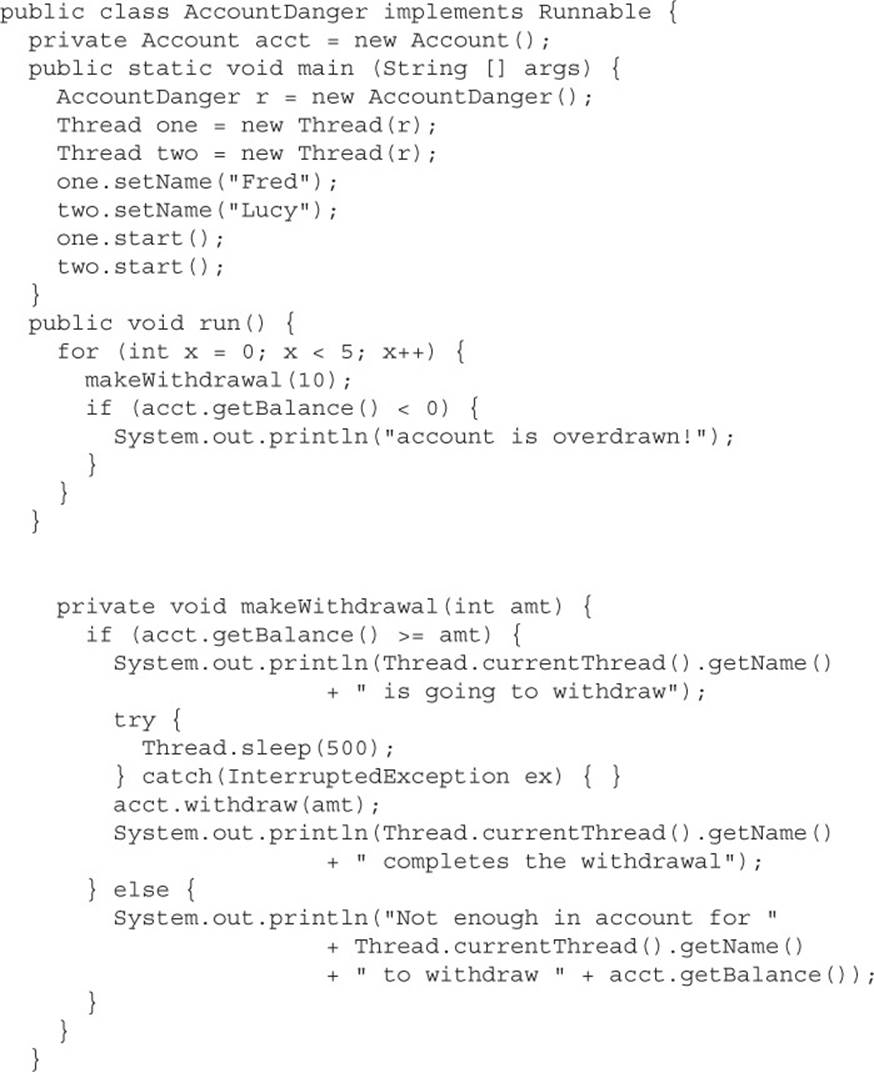
(Note: You might have to tweak this code a bit on your machine to the “account overdrawn” behavior. You might try much shorter sleep times; you might try adding a sleep to the run() method… In any case, experimenting will help you lock in the concepts.) So what happened? Is it possible that, say, Lucy checked the balance, fell asleep, Fred checked the balance, Lucy woke up and completed her withdrawal, then Fred completes his withdrawal, and in the end, they overdraw the account? Look at the (numbered) output:
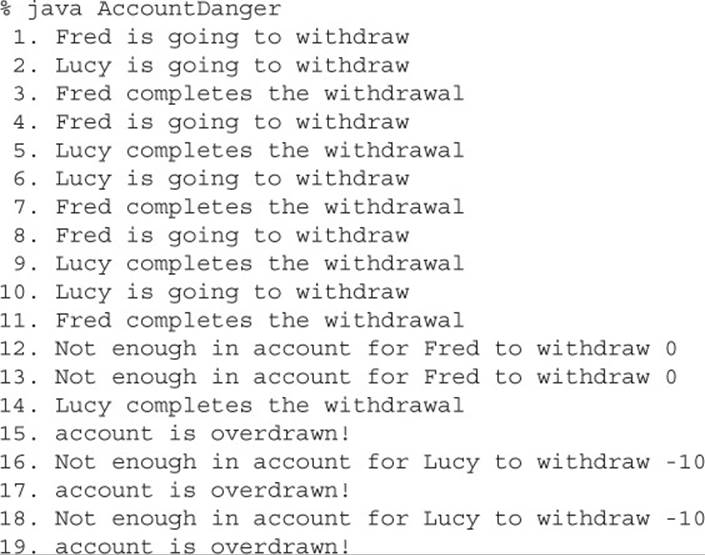
Although each time you run this code the output might be a little different, let’s walk through this particular example using the numbered lines of output. For the first four attempts, everything is fine. Fred checks the balance on line 1 and finds it’s okay. At line 2, Lucy checks the balance and finds it okay. At line 3, Fred makes his withdrawal. At this point, the balance Lucy checked for (and believes is still accurate) has actually changed since she last checked. And now Fred checks the balance again, before Lucy even completes her first withdrawal. By this point, even Fred is seeing a potentially inaccurate balance because we know Lucy is going to complete her withdrawal. It is possible, of course, that Fred will complete his before Lucy does, but that’s not what happens here.
On line 5, Lucy completes her withdrawal and then, before Fred completes his, Lucy does another check on the account on line 6. And so it continues until we get to line 8, where Fred checks the balance and sees that it’s 20. On line 9, Lucy completes a withdrawal that she had checked for earlier, and this takes the balance to 10. On line 10, Lucy checks again, sees that the balance is 10, so she knows she can do a withdrawal. But she didn’t know that Fred, too, has already checked the balance on line 8 so he thinks it’s safe to do the withdrawal!On line 11, Fred completes the withdrawal he approved on line 8. This takes the balance to zero. But Lucy still has a pending withdrawal that she got approval for on line 10! You know what’s coming.
On lines 12 and 13, Fred checks the balance and finds that there’s not enough in the account. But on line 14, Lucy completes her withdrawal and BOOM! The account is now overdrawn by 10—something we thought we were preventing by doing a balance check prior to a withdrawal.
Figure 13-4 shows the timeline of what can happen when two threads concurrently access the same object.
FIGURE 13-4 Problems with concurrent access
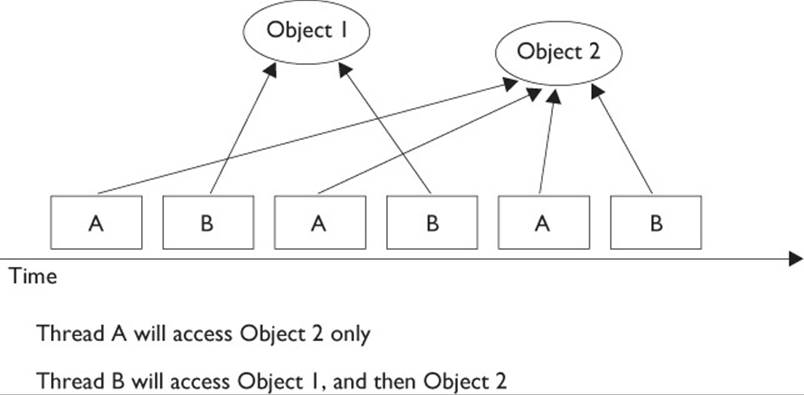
This problem is known as a “race condition,” where multiple threads can access the same resource (typically an object’s instance variables) and can produce corrupted data if one thread “races in” too quickly before an operation that should be “atomic” has completed.
Preventing the Account Overdraw So what can be done? The solution is actually quite simple. We must guarantee that the two steps of the withdrawal—checking the balance and making the withdrawal—are never split apart. We need them to always be performed as one operation, even when the thread falls asleep in between step 1 and step 2! We call this an “atomic operation” (although the physics is a little outdated—in this case, “atomic” means “indivisible”) because the operation, regardless of the number of actual statements (or underlying bytecode instructions), is completed before any other thread code that acts on the same data.
You can’t guarantee that a single thread will stay running throughout the entire atomic operation. But you can guarantee that even if the thread running the atomic operation moves in and out of the running state, no other running thread will be able to act on the same data. In other words, if Lucy falls asleep after checking the balance, we can stop Fred from checking the balance until after Lucy wakes up and completes her withdrawal.
So how do you protect the data? You must do two things:
![]() Mark the variables private.
Mark the variables private.
![]() Synchronize the code that modifies the variables.
Synchronize the code that modifies the variables.
Remember, you protect the variables in the normal way—using an access control modifier. It’s the method code that you must protect so that only one thread at a time can be executing that code. You do this with the synchronized keyword.
We can solve all of Fred and Lucy’s problems by adding one word to the code. We mark the makeWithdrawal() method synchronized as follows:

Now we’ve guaranteed that once a thread (Lucy or Fred) starts the withdrawal process by invoking makeWithdrawal(), the other thread cannot enter that method until the first one completes the process by exiting the method. The new output shows the benefit of synchronizing themakeWithdrawal() method:
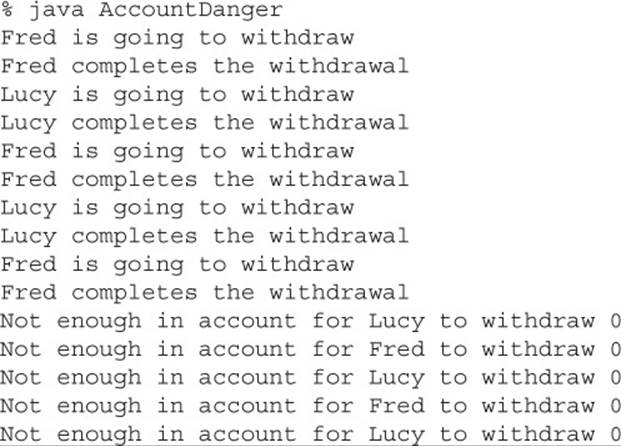
Notice that now both threads, Lucy and Fred, always check the account balance and complete the withdrawal before the other thread can check the balance.
Synchronization and Locks
How does synchronization work? With locks. Every object in Java has a built-in lock that only comes into play when the object has synchronized method code. When we enter a synchronized non-static method, we automatically acquire the lock associated with the current instance of the class whose code we’re executing (the this instance). Acquiring a lock for an object is also known as getting the lock, or locking the object, locking on the object, or synchronizing on the object. We may also use the term monitor to refer to the object whose lock we’re acquiring. Technically, the lock and the monitor are two different things, but most people talk about the two interchangeably, and we will too.
Since there is only one lock per object, if one thread has picked up the lock, no other thread can pick up the lock until the first thread releases (or returns) the lock. This means no other thread can enter the synchronized code (which means it can’t enter any synchronized method of that object) until the lock has been released. Typically, releasing a lock means the thread holding the lock (in other words, the thread currently in the synchronized method) exits the synchronized method. At that point, the lock is free until some other thread enters a synchronizedmethod on that object. Remember the following key points about locking and synchronization:
![]() Only methods (or blocks) can be synchronized, not variables or classes.
Only methods (or blocks) can be synchronized, not variables or classes.
![]() Each object has just one lock.
Each object has just one lock.
![]() Not all methods in a class need to be synchronized. A class can have both synchronized and non-synchronized methods.
Not all methods in a class need to be synchronized. A class can have both synchronized and non-synchronized methods.
![]() If two threads are about to execute a synchronized method in a class and both threads are using the same instance of the class to invoke the method, only one thread at a time will be able to execute the method. The other thread will need to wait until the first one finishes its method call. In other words, once a thread acquires the lock on an object, no other thread can enter any of the synchronized methods in that class (for that object).
If two threads are about to execute a synchronized method in a class and both threads are using the same instance of the class to invoke the method, only one thread at a time will be able to execute the method. The other thread will need to wait until the first one finishes its method call. In other words, once a thread acquires the lock on an object, no other thread can enter any of the synchronized methods in that class (for that object).
![]() If a class has both synchronized and non-synchronized methods, multiple threads can still access the class’s non-synchronized methods! If you have methods that don’t access the data you’re trying to protect, then you don’t need to synchronize them. Synchronization can cause a hit in some cases (or even deadlock if used incorrectly), so you should be careful not to overuse it.
If a class has both synchronized and non-synchronized methods, multiple threads can still access the class’s non-synchronized methods! If you have methods that don’t access the data you’re trying to protect, then you don’t need to synchronize them. Synchronization can cause a hit in some cases (or even deadlock if used incorrectly), so you should be careful not to overuse it.
![]() If a thread goes to sleep, it holds any locks it has—it doesn’t release them.
If a thread goes to sleep, it holds any locks it has—it doesn’t release them.
![]() A thread can acquire more than one lock. For example, a thread can enter a synchronized method, thus acquiring a lock, and then immediately invoke a synchronized method on a different object, thus acquiring that lock as well. As the stack unwinds, locks are released again. Also, if a thread acquires a lock and then attempts to call a synchronized method on that same object, no problem. The JVM knows that this thread already has the lock for this object, so the thread is free to call other synchronized methods on the same object, using the lock the thread already has.
A thread can acquire more than one lock. For example, a thread can enter a synchronized method, thus acquiring a lock, and then immediately invoke a synchronized method on a different object, thus acquiring that lock as well. As the stack unwinds, locks are released again. Also, if a thread acquires a lock and then attempts to call a synchronized method on that same object, no problem. The JVM knows that this thread already has the lock for this object, so the thread is free to call other synchronized methods on the same object, using the lock the thread already has.
![]() You can synchronize a block of code rather than a method.
You can synchronize a block of code rather than a method.
Because synchronization does hurt concurrency, you don’t want to synchronize any more code than is necessary to protect your data. So if the scope of a method is more than needed, you can reduce the scope of the synchronized part to something less than a full method—to just a block. We call this, strangely, a synchronized block, and it looks like this:

When a thread is executing code from within a synchronized block, including any method code invoked from that synchronized block, the code is said to be executing in a synchronized context. The real question is, synchronized on what? Or, synchronized on which object’s lock?
When you synchronize a method, the object used to invoke the method is the object whose lock must be acquired. But when you synchronize a block of code, you specify which object’s lock you want to use as the lock, so you could, for example, use some third-party object as the lock for this piece of code. That gives you the ability to have more than one lock for code synchronization within a single object.
Or you can synchronize on the current instance (this) as in the previous code. Since that’s the same instance that synchronized methods lock on, it means that you could always replace a synchronized method with a non-synchronized method containing a synchronized block. In other words, this:

is equivalent to this:

These methods both have the exact same effect, in practical terms. The compiled bytecodes may not be exactly the same for the two methods, but they could be—and any differences are not really important. The first form is shorter and more familiar to most people, but the second can be more flexible.
Can Static Methods Be Synchronized?
static methods can be synchronized. There is only one copy of the static data you’re trying to protect, so you only need one lock per class to synchronize static methods—a lock for the whole class. There is such a lock; every class loaded in Java has a corresponding instance ofjava.lang.Class representing that class. It’s that java.lang.Class instance whose lock is used to protect the static methods of the class (if they’re synchronized). There’s nothing special you have to do to synchronize a static method:

Again, this could be replaced with code that uses a synchronized block. If the method is defined in a class called MyClass, the equivalent code is as follows:

Wait—what’s that MyClass.class thing? That’s called a class literal. It’s a special feature in the Java language that tells the compiler (who tells the JVM): Go and find me the instance of Class that represents the class called MyClass. You can also do this with the following code:

However, that’s longer, ickier, and most importantly, not on the OCP exam. But it’s quick and easy to use a class literal—just write the name of the class and add .class at the end. No quotation marks needed. Now you’ve got an expression for the Class object you need to synchronize on.
EXERCISE 13-2
Synchronizing a Block of Code
In this exercise, we will attempt to synchronize a block of code. Within that block of code, we will get the lock on an object so that other threads cannot modify it while the block of code is executing. We will be creating three threads that will all attempt to manipulate the same object. Each thread will output a single letter 100 times and then increment that letter by one. The object we will be using is StringBuffer. We could synchronize on a String object, but strings cannot be modified once they are created, so we would not be able to increment the letter without generating a new String object. The final output should have 100 A’s, 100 B’s, and 100 C’s, all in unbroken lines.
1. Create a class and extend the Thread class.
2. Override the run() method of Thread. This is where the synchronized block of code will go.
3. For our three thread objects to share the same object, we will need to create a constructor that accepts a StringBuffer object in the argument.
4. The synchronized block of code will obtain a lock on the StringBuffer object from step 3.
5. Within the block, output the StringBuffer 100 times and then increment the letter in the StringBuffer. You can check Chapter 5 for StringBuffer (StringBuilder) methods that will help with this.
6. Finally, in the main() method, create a single StringBuffer object using the letter A, then create three instances of our class and start all three of them.
What Happens If a Thread Can’t Get the Lock?
If a thread tries to enter a synchronized method and the lock is already taken, the thread is said to be blocked on the object’s lock. Essentially, the thread goes into a kind of pool for that particular object and has to sit there until the lock is released and the thread can again become runnable/running. Just because a lock is released doesn’t mean any particular thread will get it. There might be three threads waiting for a single lock, for example, and there’s no guarantee that the thread that has waited the longest will get the lock first.
When thinking about blocking, it’s important to pay attention to which objects are being used for locking:
![]() Threads calling non-static synchronized methods in the same class will only block each other if they’re invoked using the same instance. That’s because they each lock on this instance, and if they’re called using two different instances, they get two locks, which do not interfere with each other.
Threads calling non-static synchronized methods in the same class will only block each other if they’re invoked using the same instance. That’s because they each lock on this instance, and if they’re called using two different instances, they get two locks, which do not interfere with each other.
![]() Threads calling static synchronized methods in the same class will always block each other—they all lock on the same Class instance.
Threads calling static synchronized methods in the same class will always block each other—they all lock on the same Class instance.
![]() A static synchronized method and a non-static synchronized method will not block each other, ever. The static method locks on a Class instance, while the non-static method locks on the this instance—these actions do not interfere with each other at all.
A static synchronized method and a non-static synchronized method will not block each other, ever. The static method locks on a Class instance, while the non-static method locks on the this instance—these actions do not interfere with each other at all.
![]() For synchronized blocks, you have to look at exactly what object has been used for locking. (What’s inside the parentheses after the word synchronized?) Threads that synchronize on the same object will block each other. Threads that synchronize on different objects will not.
For synchronized blocks, you have to look at exactly what object has been used for locking. (What’s inside the parentheses after the word synchronized?) Threads that synchronize on the same object will block each other. Threads that synchronize on different objects will not.
Table 13-1 lists the thread-related methods and whether the thread gives up its lock as a result of the call.
TABLE 13-1 Methods and Lock Status

So When Do I Need to Synchronize?
Synchronization can get pretty complicated, and you may be wondering why you would want to do this at all if you can help it. But remember the earlier “race conditions” example with Lucy and Fred making withdrawals from their account. When we use threads, we usually need to use some synchronization somewhere to make sure our methods don’t interrupt each other at the wrong time and mess up our data. Generally, any time more than one thread is accessing mutable (changeable) data, you synchronize to protect that data to make sure two threads aren’t changing it at the same time (or that one isn’t changing it at the same time the other is reading it, which is also confusing). You don’t need to worry about local variables—each thread gets its own copy of a local variable. Two threads executing the same method at the same time will use different copies of the local variables, and they won’t bother each other. However, you do need to worry about static and non-static fields if they contain data that can be changed.
For changeable data in a non-static field, you usually use a non-static method to access it. By synchronizing that method, you will ensure that any threads trying to run that method using the same instance will be prevented from simultaneous access. But a thread working with adifferent instance will not be affected because it’s acquiring a lock on the other instance. That’s what we want—threads working with the same data need to go one at a time, but threads working with different data can just ignore each other and run whenever they want to; it doesn’t matter.
For changeable data in a static field, you usually use a static method to access it. And again, by synchronizing the method, you ensure that any two threads trying to access the data will be prevented from simultaneous access, because both threads will have to acquire locks on theClass object for the class the static method’s defined in. Again, that’s what we want.
However—what if you have a non-static method that accesses a static field? Or a static method that accesses a non-static field (using an instance)? In these cases, things start to get messy quickly, and there’s a very good chance that things will not work the way you want. If you’ve got a static method accessing a non-static field and you synchronize the method, you acquire a lock on the Class object. But what if there’s another method that also accesses the non-static field, this time using a non-static method? It probably synchronizes on the current instance (this) instead. Remember that a static synchronized method and a non-static synchronized method will not block each other—they can run at the same time. Similarly, if you access a static field using a non-static method, two threads might invoke that method using two different this instances. Which means they won’t block each other because they use different locks. Which means two threads are simultaneously accessing the same static field—exactly the sort of thing we’re trying to prevent.
It gets very confusing trying to imagine all the weird things that can happen here. To keep things simple, in order to make a class thread-safe, methods that access changeable fields need to be synchronized.
Access to static fields should be done using static synchronized methods. Access to non-static fields should be done using non-static synchronized methods. For example:
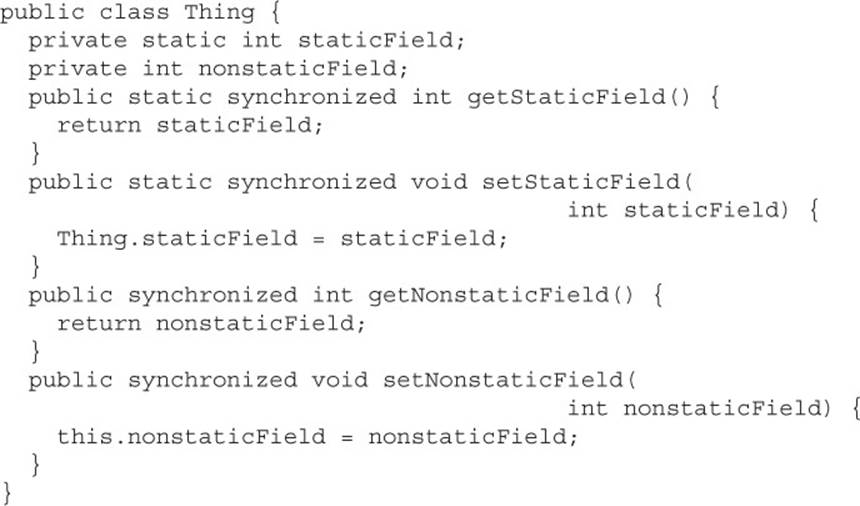
What if you need to access both static and non-static fields in a method? Well, there are ways to do that, but it’s beyond what you need for the exam. You will live a longer, happier life if you JUST DON’T DO IT. Really. Would we lie?
Thread-Safe Classes
When a class has been carefully synchronized to protect its data (using the rules just given or using more complicated alternatives), we say the class is “thread-safe.” Many classes in the Java APIs already use synchronization internally in order to make the class “thread-safe.” For example, StringBuffer and StringBuilder are nearly identical classes, except that all the methods in StringBuffer are synchronized when necessary, while those in StringBuilder are not. Generally, this makes StringBuffer safe to use in a multithreaded environment, whileStringBuilder is not. (In return, StringBuilder is a little bit faster because it doesn’t bother synchronizing.) However, even when a class is “thread-safe,” it is often dangerous to rely on these classes to provide the thread protection you need. (C’mon, the repeated quotes used around “thread-safe” had to be a clue, right?) You still need to think carefully about how you use these classes. As an example, consider the following class:
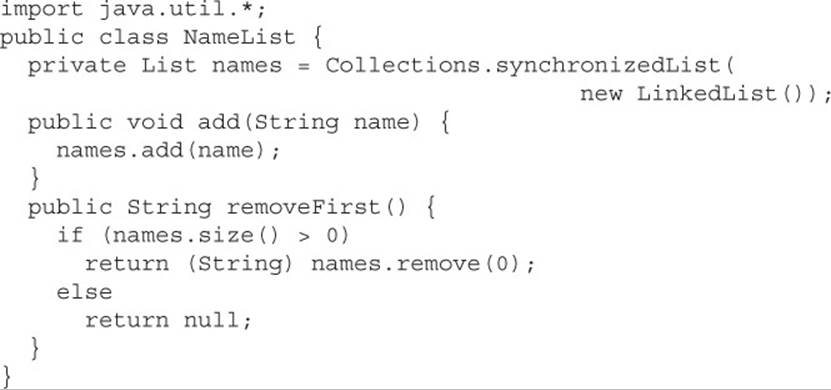
The method Collections.synchronizedList() returns a List whose methods are all synchronized and “thread-safe” according to the documentation (like a Vector—but since this is the 21st century, we’re not going to use a Vector here). The question is, can the NameList class be used safely from multiple threads? It’s tempting to think that yes, since the data in names is in a synchronized collection, the NameList class is “safe” too. However that’s not the case—the removeFirst() may sometimes throw a IndexOutOfBoundsException. What’s the problem? Doesn’t it correctly check the size() of names before removing anything to make sure there’s something there? How could this code fail? Let’s try to use NameList like this:

What might happen here is that one of the threads will remove the one name and print it, and then the other will try to remove a name and get null. If we think just about the calls to names.size() and names.get(0), they occur in this order:
Thread t1 executes names.size(), which returns 1.
Thread t1 executes names.remove(0), which returns Ozymandias.
Thread t2 executes names.size(), which returns 0.
Thread t2 does not call remove(0).
The output here is
Ozymandias
null
However, if we run the program again, something different might happen:

The thing to realize here is that in a “thread-safe” class like the one returned by synchronizedList(), each individual method is synchronized. So names.size() is synchronized, and names.remove(0) is synchronized. But nothing prevents another thread from doing something else to the list in between those two calls. And that’s where problems can happen.
There’s a solution here: Don’t rely on Collections.synchronizedList(). Instead, synchronize the code yourself:

Now the entire removeFirst() method is synchronized, and once one thread starts it and calls names.size(), there’s no way the other thread can cut in and steal the last name. The other thread will just have to wait until the first thread completes the removeFirst() method.
The moral here is that just because a class is described as “thread-safe” doesn’t mean it is always thread-safe. If individual methods are synchronized, that may not be enough—you may be better off putting in synchronization at a higher level (i.e., put it in the block or method thatcalls the other methods). Once you do that, the original synchronization (in this case, the synchronization inside the object returned by Collections.synchronizedList()) may well become redundant.
Thread Deadlock
Perhaps the scariest thing that can happen to a Java program is deadlock. Deadlock occurs when two threads are blocked, with each waiting for the other’s lock. Neither can run until the other gives up its lock, so they’ll sit there forever.
This can happen, for example, when thread A hits synchronized code, acquires a lock B, and then enters another method (still within the synchronized code it has the lock on) that’s also synchronized. But thread A can’t get the lock to enter this synchronized code—block C—because another thread D has the lock already. So thread A goes off to the waiting-for-the-C-lock pool, hoping that thread D will hurry up and release the lock (by completing the synchronized method). But thread A will wait a very long time indeed, because while thread D picked up lock C, it then entered a method synchronized on lock B. Obviously, thread D can’t get the lock B because thread A has it. And thread A won’t release it until thread D releases lock C. But thread D won’t release lock C until after it can get lock B and continue. And there they sit. The following example demonstrates deadlock:

Assume that read() is started by one thread and write() is started by another. If there are two different threads that may read and write independently, there is a risk of deadlock at line 8 or 16. The reader thread will have resourceA, the writer thread will have resourceB, and both will get stuck waiting for the other.
Code like this almost never results in deadlock because the CPU has to switch from the reader thread to the writer thread at a particular point in the code, and the chances of deadlock occurring are very small. The application may work fine 99.9 percent of the time.
The preceding simple example is easy to fix; just swap the order of locking for either the reader or the writer at lines 16 and 17 (or lines 8 and 9). More complex deadlock situations can take a long time to figure out.
Regardless of how little chance there is for your code to deadlock, the bottom line is that if you deadlock, you’re dead. There are design approaches that can help avoid deadlock, including strategies for always acquiring locks in a predetermined order.
But that’s for you to study and is beyond the scope of this book. We’re just trying to get you through the exam. If you learn everything in this chapter, though, you’ll still know more about threads than most experienced Java programmers.
CERTIFICATION OBJECTIVES
Thread Interaction (OCP Objectives 10.3 and 10.4)
10.3 Synchronize thread access to shared data.
10.4 Identify potential threading problems.
The last thing we need to look at is how threads can interact with one another to communicate about—among other things—their locking status. The Object class has three methods, wait(), notify(), and notifyAll(), that help threads communicate the status of an event that the threads care about. For example, if one thread is a mail-delivery thread and one thread is a mail-processor thread, the mail-processor thread has to keep checking to see if there’s any mail to process. Using the wait and notify mechanism, the mail-processor thread could check for mail, and if it doesn’t find any, it can say, “Hey, I’m not going to waste my time checking for mail every two seconds. I’m going to go hang out, and when the mail deliverer puts something in the mailbox, have him notify me so I can go back to runnable and do some work.” In other words, using wait() and notify() lets one thread put itself into a “waiting room” until some other thread notifies it that there’s a reason to come back out.
One key point to remember (and keep in mind for the exam) about wait/notify is this:
wait(), notify(), and notifyAll() must be called from within a synchronized context! A thread can’t invoke a wait or notify method on an object unless it owns that object’s lock.
Here we’ll present an example of two threads that depend on each other to proceed with their execution, and we’ll show how to use wait() and notify() to make them interact safely and at the proper moment.
Think of a computer-controlled machine that cuts pieces of fabric into different shapes and an application that allows users to specify the shape to cut. The current version of the application has one thread, which loops, first asking the user for instructions, and then directs the hardware to cut the requested shape:

This design is not optimal because the user can’t do anything while the machine is busy and while there are other shapes to define. We need to improve the situation.
A simple solution is to separate the processes into two different threads, one of them interacting with the user and another managing the hardware. The user thread sends the instructions to the hardware thread and then goes back to interacting with the user immediately. The hardware thread receives the instructions from the user thread and starts directing the machine immediately. Both threads use a common object to communicate, which holds the current design being processed.
The following pseudocode shows this design:

The problem now is to get the hardware thread to process the machine steps as soon as they are available. Also, the user thread should not modify them until they have all been sent to the hardware. The solution is to use wait() and notify(), and also to synchronize some of the code.
The methods wait() and notify(), remember, are instance methods of Object. In the same way that every object has a lock, every object can have a list of threads that are waiting for a signal (a notification) from the object. A thread gets on this waiting list by executing the wait()method of the target object. From that moment, it doesn’t execute any further instructions until the notify() method of the target object is called. If many threads are waiting on the same object, only one will be chosen (in no guaranteed order) to proceed with its execution. If there are no threads waiting, then no particular action is taken. Let’s take a look at some real code that shows one object waiting for another object to notify it (take note, it is somewhat complex):
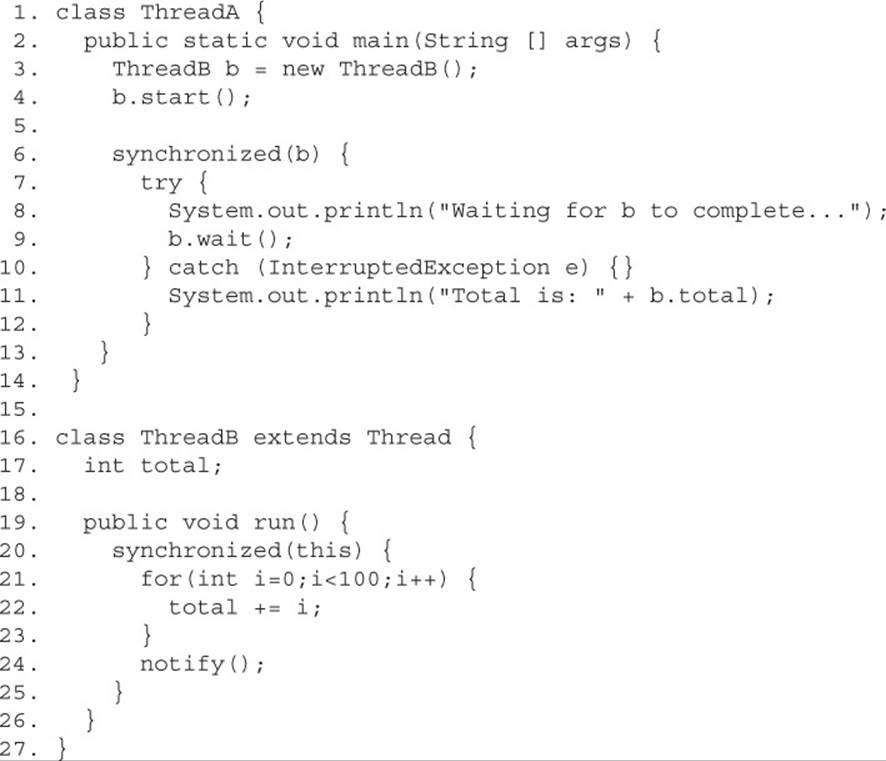
This program contains two objects with threads: ThreadA contains the main thread, and ThreadB has a thread that calculates the sum of all numbers from 0 through 99. As soon as line 4 calls the start() method, ThreadA will continue with the next line of code in its own class, which means it could get to line 11 before ThreadB has finished the calculation. To prevent this, we use the wait() method in line 9.
Notice in line 6 the code synchronizes itself with the object b—this is because in order to call wait() on the object, ThreadA must own a lock on b. For a thread to call wait() or notify(), the thread has to be the owner of the lock for that object. When the thread waits, it temporarily releases the lock for other threads to use, but it will need it again to continue execution. It’s common to find code like this:

The preceding code waits until notify() is called on anotherObject.
synchronized(this) { notify(); }
This code notifies a single thread currently waiting on the this object. The lock can be acquired much earlier in the code, such as in the calling method. Note that if the thread calling wait() does not own the lock, it will throw an IllegalMonitorStateException. This exception is not a checked exception, so you don’t have to catch it explicitly. You should always be clear whether a thread has the lock of an object in any given block of code.
Notice in lines 7–10 there is a try/catch block around the wait() method. A waiting thread can be interrupted in the same way as a sleeping thread, so you have to take care of the exception:

In the fabric example, the way to use these methods is to have the hardware thread wait on the shape to be available and the user thread to notify after it has written the steps. The machine steps may comprise global steps, such as moving the required fabric to the cutting area, and a number of substeps, such as the direction and length of a cut. As an example, they could be

It is important that the user thread does not modify the machine steps while the hardware thread is using them, so this reading and writing should be synchronized.
The resulting code would look like this:

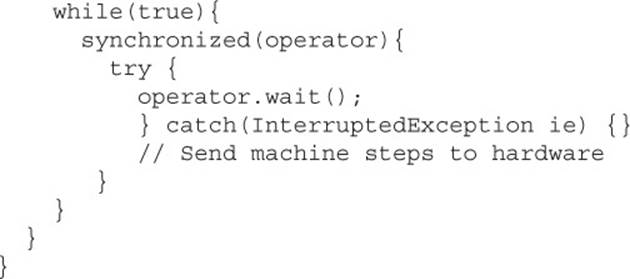
The machine thread, once started, will immediately go into the waiting state and will wait patiently until the operator sends the first notification. At that point, it is the operator thread that owns the lock for the object, so the hardware thread gets stuck for a while. It’s only after the operator thread abandons the synchronized block that the hardware thread can really start processing the machine steps.
While one shape is being processed by the hardware, the user may interact with the system and specify another shape to be cut. When the user is finished with the shape and it is time to cut it, the operator thread attempts to enter the synchronized block, maybe blocking until the machine thread has finished with the previous machine steps. When the machine thread has finished, it repeats the loop, going again to the waiting state (and therefore releasing the lock). Only then can the operator thread enter the synchronized block and overwrite the machine steps with the new ones.
Having two threads is definitely an improvement over having one, although in this implementation, there is still a possibility of making the user wait. A further improvement would be to have many shapes in a queue, thereby reducing the possibility of requiring the user to wait for the hardware.
There is also a second form of wait() that accepts a number of milliseconds as a maximum time to wait. If the thread is not interrupted, it will continue normally whenever it is notified or the specified timeout has elapsed. This normal continuation consists of getting out of the waiting state, but to continue execution, it will have to get the lock for the object:


When the wait() method is invoked on an object, the thread executing that code gives up its lock on the object immediately. However, when notify() is called, that doesn’t mean the thread gives up its lock at that moment. If the thread is still completing synchronized code, the lock is not released until the thread moves out of synchronized code. So just because notify() is called, this doesn’t mean the lock becomes available at that moment.
Using notifyAll() When Many Threads May Be Waiting
In most scenarios, it’s preferable to notify all of the threads that are waiting on a particular object. If so, you can use notifyAll() on the object to let all the threads rush out of the waiting area and back to runnable. This is especially important if you have several threads waiting on one object, but for different reasons, and you want to be sure that the right thread (along with all of the others) is notified.
notifyAll(); // Will notify all waiting threads
All of the threads will be notified and start competing to get the lock. As the lock is used and released by each thread, all of them will get into action without a need for further notification.
As we said earlier, an object can have many threads waiting on it, and using notify() will affect only one of them. Which one, exactly, is not specified and depends on the JVM implementation, so you should never rely on a particular thread being notified in preference to another.
In cases in which there might be a lot more waiting, the best way to do this is by using notifyAll(). Let’s take a look at this in some code. In this example, there is one class that performs a calculation and many readers that are waiting to receive the completed calculation. At any given moment, many readers may be waiting.
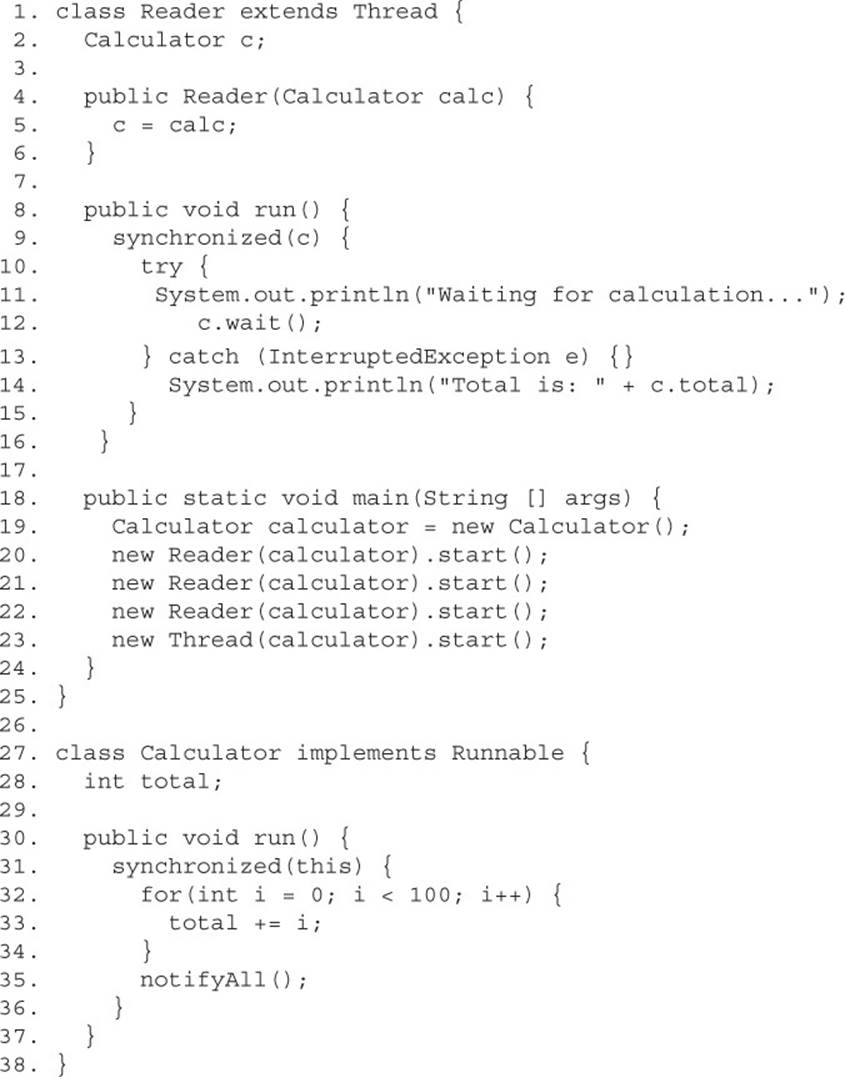
The program starts three threads that are all waiting to receive the finished calculation (lines 18–24) and then starts the calculator with its calculation. Note that if the run() method at line 30 used notify() instead of notifyAll(), only one reader would be notified instead of all the readers.
Using wait() in a Loop
Actually, both of the previous examples (Machine/Operator and Reader/Calculator) had a common problem. In each one, there was at least one thread calling wait() and another thread calling notify() or notifyAll(). This works well enough as long as the waiting threads have actually started waiting before the other thread executes the notify() or notifyAll(). But what happens if, for example, the Calculator runs first and calls notify() before the Readers have started waiting? This could happen, since we can’t guarantee the order in which the different parts of the thread will execute. Unfortunately, when the Readers run, they just start waiting right away. They don’t do anything to see if the event they’re waiting for has already happened. So if the Calculator has already called notifyAll(), it’s not going to call notifyAll() again—and the waiting Readers will keep waiting forever. This is probably not what the programmer wanted to happen. Almost always, when you want to wait for something, you also need to be able to check if it has already happened. Generally, the best way to solve this is to put in some sort of loop that checks on some sort of conditional expressions and only waits if the thing you’re waiting for has not yet happened. Here’s a modified, safer version of the earlier fabric-cutting machine example:
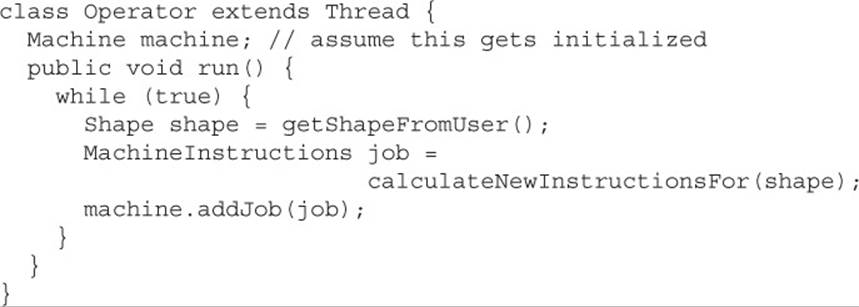
The operator will still keep on looping forever, getting more shapes from users, calculating new instructions for those shapes, and sending them to the machine. But now the logic for notify() has been moved into the addJob() method in the Machine class:

A machine keeps a list of the jobs it’s scheduled to do. Whenever an operator adds a new job to the list, it calls the addJob() method and adds the new job to the list. Meanwhile, the run() method just keeps looping, looking for any jobs on the list. If there are no jobs, it will start waiting. If it’s notified, it will stop waiting and then recheck the loop condition: Is the list still empty? In practice, this double-check is probably not necessary, as the only time a notify() is ever sent is when a new job has been added to the list. However, it’s a good idea to require the thread to recheck the isEmpty() condition whenever it’s been woken up because it’s possible that a thread has accidentally sent an extra notify() that was not intended. There’s also a possible situation called spontaneous wakeup that may exist in some situations—a thread may wake up even though no code has called notify() or notifyAll(). (At least, no code you know about has called these methods. Sometimes, the JVM may call notify() for reasons of its own, or code in some other class calls it for reasons you just don’t know.) What this means is that when your thread wakes up from a wait(), you don’t know for sure why it was awakened. By putting the wait() method in a while loop and rechecking the condition that represents what we were waiting for, we ensure that whatever the reason we woke up, we will re-enter the wait() if (and only if) the thing we were waiting for has not happened yet. In the Machine class, the thing we were waiting for is for the jobs list to not be empty. If it’s empty, we wait, and if it’s not, we don’t.
Note also that both the run() method and the addJob() method synchronize on the same object—the jobs list. This is for two reasons. One is because we’re calling wait() and notify() on this instance, so we need to synchronize in order to avoid an IllegalMonitorStateException. The other reason is that the data in the jobs list is changeable data stored in a field that is accessed by two different threads. We need to synchronize in order to access that changeable data safely. Fortunately, the same synchronized blocks that allow us to wait() and notify() also provide the required thread safety for our other access to changeable data. In fact, this is a main reason why synchronization is required to use wait() and notify() in the first place—you almost always need to share some mutable data between threads at the same time, and that means you need synchronization. Notice that the synchronized block in addJob() is big enough to also include the call to jobs.add(job)—which modifies shared data. And the synchronized block in run() is large enough to include the whole while loop—which includes the call tojobs.isEmpty(), which accesses shared data.
The moral here is that when you use wait() and notify() or notifyAll(), you should almost always also have a while loop around the wait() that checks a condition and forces continued waiting until the condition is met. And you should also make use of the required synchronization for the wait() and notify() calls to also protect whatever other data you’re sharing between threads. If you see code that fails to do this, there’s usually something wrong with the code—even if you have a hard time seeing what exactly the problem is.

The methods wait(), notify(), and notifyAll() are methods of only java.lang.Object, not of java.lang.Thread or java.lang.Runnable. Be sure you know which methods are defined in Thread, which in Object, and which in Runnable (just run(), so that’s an easy one). Of the key methods in Thread, be sure you know which are static—sleep() and yield(), and which are not static—join() and start(). Table 13-2 lists the key methods you’ll need to know for the exam, with the static methods shown in italics.
TABLE 13-2 Key Thread Methods

CERTIFICATION SUMMARY
This chapter covered the required thread knowledge you’ll need to apply on the certification exam. Threads can be created by either extending the Thread class or implementing the Runnable interface. The only method that must be overridden in the Runnable interface is the run()method, but the thread doesn’t become a thread of execution until somebody calls the Thread object’s start() method. We also looked at how the sleep() method can be used to pause a thread, and we saw that when an object goes to sleep, it holds onto any locks it acquired prior to sleeping.
We looked at five thread states: new, runnable, running, blocked/waiting/sleeping, and dead. You learned that when a thread is dead, it can never be restarted even if it’s still a valid object on the heap. We saw that there is only one way a thread can transition to running, and that’s from runnable. However, once running, a thread can become dead, go to sleep, wait for another thread to finish, block on an object’s lock, wait for a notification, or return to runnable.
You saw how two threads acting on the same data can cause serious problems (remember Lucy and Fred’s bank account?). We saw that to let one thread execute a method but prevent other threads from running the same object’s method, we use the synchronized keyword. To coordinate activity between different threads, use the wait(), notify(), and notifyAll() methods.
TWO-MINUTE DRILL
Here are some of the key points from each certification objective in this chapter. Photocopy it and sleep with it under your pillow for complete absorption.
Defining, Instantiating, and Starting Threads (OCP Objective 10.1)
![]() Threads can be created by extending Thread and overriding the public void run() method.
Threads can be created by extending Thread and overriding the public void run() method.
![]() Thread objects can also be created by calling the Thread constructor that takes a Runnable argument. The Runnable object is said to be the target of the thread.
Thread objects can also be created by calling the Thread constructor that takes a Runnable argument. The Runnable object is said to be the target of the thread.
![]() You can call start() on a Thread object only once. If start() is called more than once on a Thread object, it will throw a IllegalThreadStateException.
You can call start() on a Thread object only once. If start() is called more than once on a Thread object, it will throw a IllegalThreadStateException.
![]() It is legal to create many Thread objects using the same Runnable object as the target.
It is legal to create many Thread objects using the same Runnable object as the target.
![]() When a Thread object is created, it does not become a thread of execution until its start() method is invoked. When a Thread object exists but hasn’t been started, it is in the new state and is not considered alive.
When a Thread object is created, it does not become a thread of execution until its start() method is invoked. When a Thread object exists but hasn’t been started, it is in the new state and is not considered alive.
Transitioning Between Thread States (OCP Objective 10.2)
![]() Once a new thread is started, it will always enter the runnable state.
Once a new thread is started, it will always enter the runnable state.
![]() The thread scheduler can move a thread back and forth between the runnable state and the running state.
The thread scheduler can move a thread back and forth between the runnable state and the running state.
![]() For a typical single-processor machine, only one thread can be running at a time, although many threads may be in the runnable state.
For a typical single-processor machine, only one thread can be running at a time, although many threads may be in the runnable state.
![]() There is no guarantee that the order in which threads were started determines the order in which they’ll run.
There is no guarantee that the order in which threads were started determines the order in which they’ll run.
![]() There’s no guarantee that threads will take turns in any fair way. It’s up to the thread scheduler, as determined by the particular virtual machine implementation. If you want a guarantee that your threads will take turns, regardless of the underlying JVM, you can use the sleep()method. This prevents one thread from hogging the running process while another thread starves. (In most cases, though, yield() works well enough to encourage your threads to play together nicely.)
There’s no guarantee that threads will take turns in any fair way. It’s up to the thread scheduler, as determined by the particular virtual machine implementation. If you want a guarantee that your threads will take turns, regardless of the underlying JVM, you can use the sleep()method. This prevents one thread from hogging the running process while another thread starves. (In most cases, though, yield() works well enough to encourage your threads to play together nicely.)
![]() A running thread may enter a blocked/waiting state by a wait(), sleep(), or join() call.
A running thread may enter a blocked/waiting state by a wait(), sleep(), or join() call.
![]() A running thread may enter a blocked/waiting state because it can’t acquire the lock for a synchronized block of code.
A running thread may enter a blocked/waiting state because it can’t acquire the lock for a synchronized block of code.
![]() When the sleep or wait is over, or an object’s lock becomes available, the thread can only reenter the runnable state. It will go directly from waiting to running (well, for all practical purposes anyway).
When the sleep or wait is over, or an object’s lock becomes available, the thread can only reenter the runnable state. It will go directly from waiting to running (well, for all practical purposes anyway).
![]() A dead thread cannot be started again.
A dead thread cannot be started again.
Sleep, Yield, and Join (OCP Objective 10.2)
![]() Sleeping is used to delay execution for a period of time, and no locks are released when a thread goes to sleep.
Sleeping is used to delay execution for a period of time, and no locks are released when a thread goes to sleep.
![]() A sleeping thread is guaranteed to sleep for at least the time specified in the argument to the sleep() method (unless it’s interrupted), but there is no guarantee as to when the newly awakened thread will actually return to running.
A sleeping thread is guaranteed to sleep for at least the time specified in the argument to the sleep() method (unless it’s interrupted), but there is no guarantee as to when the newly awakened thread will actually return to running.
![]() The sleep() method is a static method that sleeps the currently executing thread’s state. One thread cannot tell another thread to sleep.
The sleep() method is a static method that sleeps the currently executing thread’s state. One thread cannot tell another thread to sleep.
![]() The setPriority() method is used on Thread objects to give threads a priority of between 1 (low) and 10 (high), although priorities are not guaranteed, and not all JVMs recognize 10 distinct priority levels—some levels may be treated as effectively equal.
The setPriority() method is used on Thread objects to give threads a priority of between 1 (low) and 10 (high), although priorities are not guaranteed, and not all JVMs recognize 10 distinct priority levels—some levels may be treated as effectively equal.
![]() If not explicitly set, a thread’s priority will have the same priority as the thread that created it.
If not explicitly set, a thread’s priority will have the same priority as the thread that created it.
![]() The yield() method may cause a running thread to back out if there are runnable threads of the same priority. There is no guarantee that this will happen, and there is no guarantee that when the thread backs out there will be a different thread selected to run. A thread might yield and then immediately reenter the running state.
The yield() method may cause a running thread to back out if there are runnable threads of the same priority. There is no guarantee that this will happen, and there is no guarantee that when the thread backs out there will be a different thread selected to run. A thread might yield and then immediately reenter the running state.
![]() The closest thing to a guarantee is that at any given time, when a thread is running, it will usually not have a lower priority than any thread in the runnable state. If a low-priority thread is running when a high-priority thread enters runnable, the JVM will usually preempt the running low-priority thread and put the high-priority thread in.
The closest thing to a guarantee is that at any given time, when a thread is running, it will usually not have a lower priority than any thread in the runnable state. If a low-priority thread is running when a high-priority thread enters runnable, the JVM will usually preempt the running low-priority thread and put the high-priority thread in.
![]() When one thread calls the join() method of another thread, the currently running thread will wait until the thread it joins with has completed. Think of the join() method as saying, “Hey, thread, I want to join on to the end of you. Let me know when you’re done, so I can enter the runnable state.”
When one thread calls the join() method of another thread, the currently running thread will wait until the thread it joins with has completed. Think of the join() method as saying, “Hey, thread, I want to join on to the end of you. Let me know when you’re done, so I can enter the runnable state.”
Concurrent Access Problems and Synchronized Threads (OCP Objectives 10.3 and 10.4)
![]() synchronized methods prevent more than one thread from accessing an object’s critical method code simultaneously.
synchronized methods prevent more than one thread from accessing an object’s critical method code simultaneously.
![]() You can use the synchronized keyword as a method modifier or to start a synchronized block of code.
You can use the synchronized keyword as a method modifier or to start a synchronized block of code.
![]() To synchronize a block of code (in other words, a scope smaller than the whole method), you must specify an argument that is the object whose lock you want to synchronize on.
To synchronize a block of code (in other words, a scope smaller than the whole method), you must specify an argument that is the object whose lock you want to synchronize on.
![]() While only one thread can be accessing synchronized code of a particular instance, multiple threads can still access the same object’s unsynchronized code.
While only one thread can be accessing synchronized code of a particular instance, multiple threads can still access the same object’s unsynchronized code.
![]() When a thread goes to sleep, its locks will be unavailable to other threads.
When a thread goes to sleep, its locks will be unavailable to other threads.
![]() static methods can be synchronized using the lock from the java.lang .Class instance representing that class.
static methods can be synchronized using the lock from the java.lang .Class instance representing that class.
Communicating with Objects by Waiting and Notifying (OCP Objectives 10.3 and 10.4)
![]() The wait() method lets a thread say, “There’s nothing for me to do now, so put me in your waiting pool and notify me when something happens that I care about.” Basically, a wait() call means “let me wait in your pool” or “add me to your waiting list.”
The wait() method lets a thread say, “There’s nothing for me to do now, so put me in your waiting pool and notify me when something happens that I care about.” Basically, a wait() call means “let me wait in your pool” or “add me to your waiting list.”
![]() The notify() method is used to send a signal to one and only one of the threads that are waiting in that same object’s waiting pool.
The notify() method is used to send a signal to one and only one of the threads that are waiting in that same object’s waiting pool.
![]() The notify() method CANNOT specify which waiting thread to notify.
The notify() method CANNOT specify which waiting thread to notify.
![]() The method notifyAll() works in the same way as notify(), only it sends the signal to all of the threads waiting on the object.
The method notifyAll() works in the same way as notify(), only it sends the signal to all of the threads waiting on the object.
![]() All three methods—wait(), notify(), and notifyAll()—must be called from within a synchronized context! A thread invokes wait() or notify() on a particular object, and the thread must currently hold the lock on that object.
All three methods—wait(), notify(), and notifyAll()—must be called from within a synchronized context! A thread invokes wait() or notify() on a particular object, and the thread must currently hold the lock on that object.
Deadlocked Threads (OCP Objective 10.4)
![]() Deadlocking is when thread execution grinds to a halt because the code is waiting for locks to be removed from objects.
Deadlocking is when thread execution grinds to a halt because the code is waiting for locks to be removed from objects.
![]() Deadlocking can occur when a locked object attempts to access another locked object that is trying to access the first locked object. In other words, both threads are waiting for each other’s locks to be released; therefore, the locks will never be released!
Deadlocking can occur when a locked object attempts to access another locked object that is trying to access the first locked object. In other words, both threads are waiting for each other’s locks to be released; therefore, the locks will never be released!
![]() Deadlocking is bad. Don’t do it.
Deadlocking is bad. Don’t do it.
SELF TEST
The following questions will help you measure your understanding of the material presented in this chapter. If you have a rough time with some of these at first, don’t beat yourself up. Some of these questions are long and intricate. Expect long and intricate questions on the real exam too!
1. The following block of code creates a Thread using a Runnable target:
![]()
Which of the following classes can be used to create the target so that the preceding code compiles correctly?
A. public class MyRunnable extends Runnable{public void run(){}}
B. public class MyRunnable extends Object{public void run(){}}
C. public class MyRunnable implements Runnable{public void run(){}}
D. public class MyRunnable implements Runnable{void run(){}}
E. public class MyRunnable implements Runnable{public void start(){}}
2. Given:
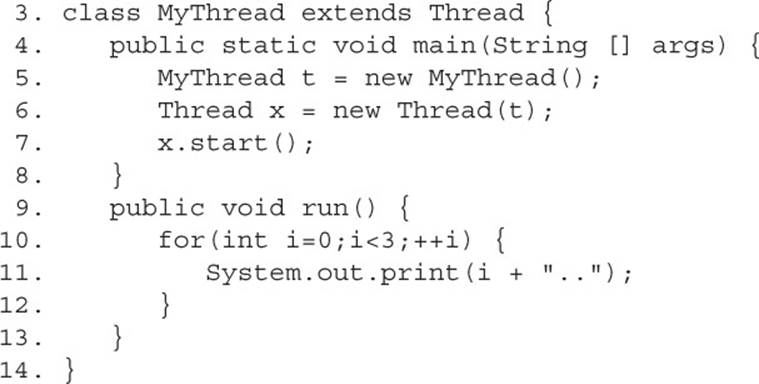
What is the result of this code?
A. Compilation fails
B. 1..2..3..
C. 0..1..2..3..
D. 0..1..2..
E. An exception occurs at runtime
3. Given:

The static method Thread.currentThread() returns a reference to the currently executing Thread object. What is the result of this code?
A. Each String in the array lines will output, with a one-second pause between lines
B. Each String in the array lines will output, with no pause in between because this method is not executed in a Thread
C. Each String in the array lines will output, and there is no guarantee that there will be a pause because currentThread() may not retrieve this thread
D. This code will not compile
E. Each String in the lines array will print, with at least a one-second pause between lines
4. Assume you have a class that holds two private variables: a and b. Which of the following pairs can prevent concurrent access problems in that class? (Choose all that apply.)
A. public int read(){return a+b;} public void set(int a, int b){this.a=a;this.b=b;}
B. public synchronized int read(){return a+b;} public synchronized void set(int a, int b){this.a=a;this.b=b;}
C. public int read(){synchronized(a){return a+b;}} public void set(int a, int b){synchronized(a){this.a=a;this.b=b;}}
D. public int read(){synchronized(a){return a+b;}} public void set(int a, int b){synchronized(b){this.a=a;this.b=b;}}
E. public synchronized(this) int read(){return a+b;} public synchronized(this) void set(int a, int b){this.a=a;this.b=b;}
F. public int read(){synchronized(this){return a+b;}} public void set(int a, int b){synchronized(this){this.a=a;this.b=b;}}
5. Given:
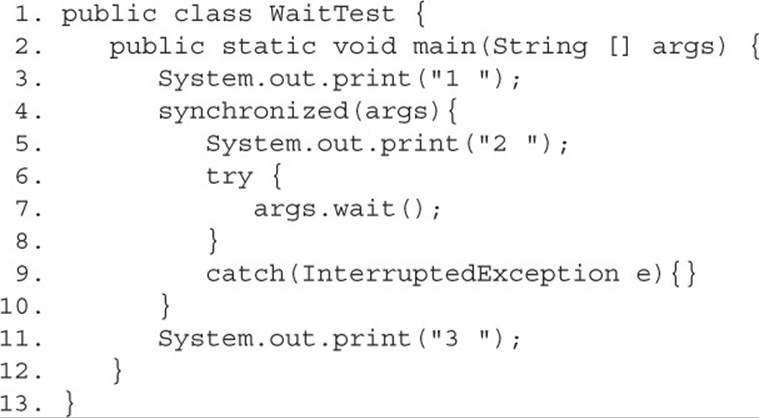
What is the result of trying to compile and run this program?
A. It fails to compile because the IllegalMonitorStateException of wait() is not dealt with in line 7
B. 1 2 3
C. 1 3
D. 1 2
E. At runtime, it throws an IllegalMonitorStateException when trying to wait
F. It will fail to compile because it has to be synchronized on the this object
6. Assume the following method is properly synchronized and called from a thread A on an object B:
wait(2000);
After calling this method, when will thread A become a candidate to get another turn at the CPU?
A. After object B is notified, or after two seconds
B. After the lock on B is released, or after two seconds
C. Two seconds after object B is notified
D. Two seconds after lock B is released
7. Which are true? (Choose all that apply.)
A. The notifyAll() method must be called from a synchronized context
B. To call wait(), an object must own the lock on the thread
C. The notify() method is defined in class java.lang.Thread
D. When a thread is waiting as a result of wait(), it releases its lock
E. The notify() method causes a thread to immediately release its lock
F. The difference between notify() and notifyAll() is that notifyAll() notifies all waiting threads, regardless of the object they’re waiting on
8. Given this scenario: This class is intended to allow users to write a series of messages so that each message is identified with a timestamp and the name of the thread that wrote the message:
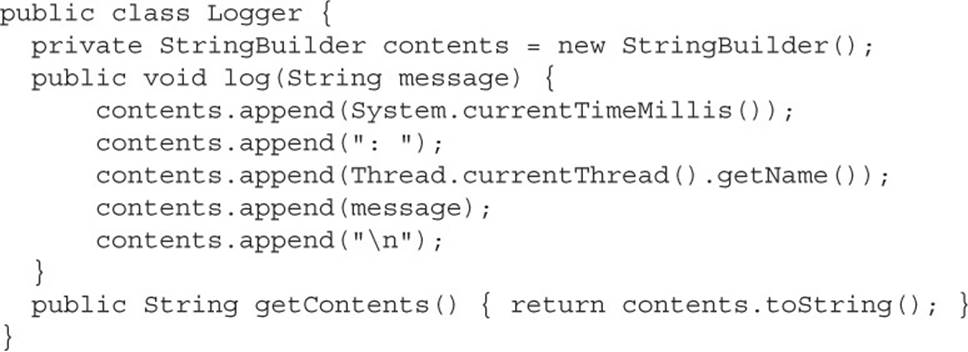
How can we ensure that instances of this class can be safely used by multiple threads?
A. This class is already thread-safe
B. Replacing StringBuilder with StringBuffer will make this class thread-safe
C. Synchronize the log() method only
D. Synchronize the getContents() method only
E. Synchronize both log() and getContents()
F. This class cannot be made thread-safe
9. Given:

What is the result of this code?
A. It prints X and exits
B. It prints X and never exits
C. It prints XY and exits almost immediately
D. It prints XY with a 10-second delay between X and Y
E. It prints XY with a 10,000-second delay between X and Y
F. The code does not compile
G. An exception is thrown at runtime
10. Given:
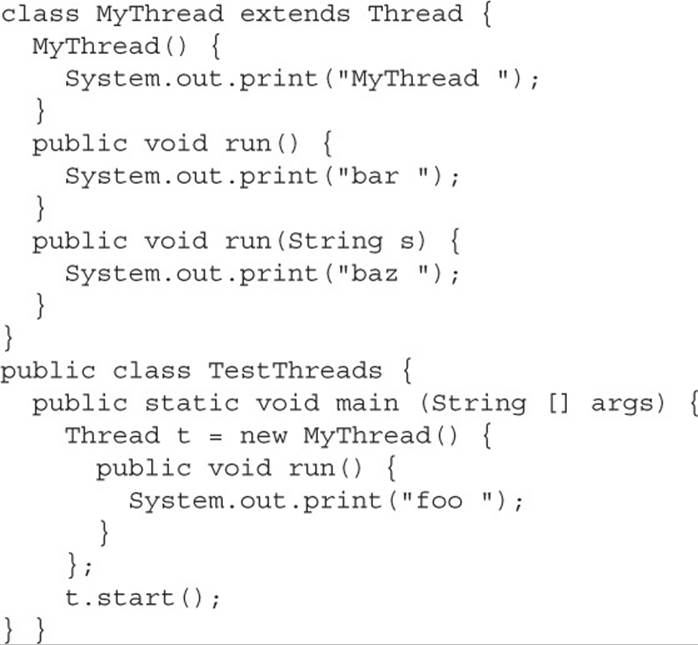
What is the result?
A. foo
B. MyThread foo
C. MyThread bar
D. foo bar
E. foo bar baz
F. bar foo
G. Compilation fails
H. An exception is thrown at runtime
11. Given:

Which of the following pairs of method invocations could NEVER be executing at the same time? (Choose all that apply.)
A. x.a() in thread1, and x.a() in thread2
B. x.a() in thread1, and x.b() in thread2
C. x.a() in thread1, and y.a() in thread2
D. x.a() in thread1, and y.b() in thread2
E. x.b() in thread1, and x.a() in thread2
F. x.b() in thread1, and x.b() in thread2
G. x.b() in thread1, and y.a() in thread2
H. x.b() in thread1, and y.b() in thread2
12. Given:
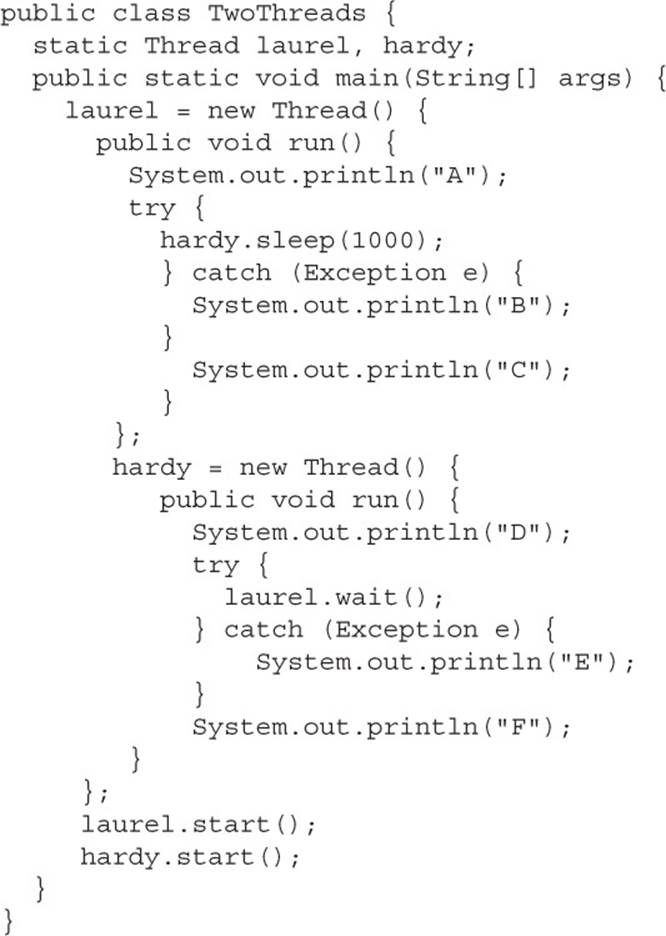
Which letters will eventually appear somewhere in the output? (Choose all that apply.)
A. A
B. B
C. C
D. D
E. E
F. F
G. The answer cannot be reliably determined
H. The code does not compile
13. Given:

And given the following five fragments:

When the five fragments are inserted, one at a time at line 9, which are true? (Choose all that apply.)
A. All five will compile
B. Only one might produce the output 4 4
C. Only one might produce the output 4 2
D. Exactly two might produce the output 4 4
E. Exactly two might produce the output 4 2
F. Exactly three might produce the output 4 4
G. Exactly three might produce the output 4 2
14. Given:
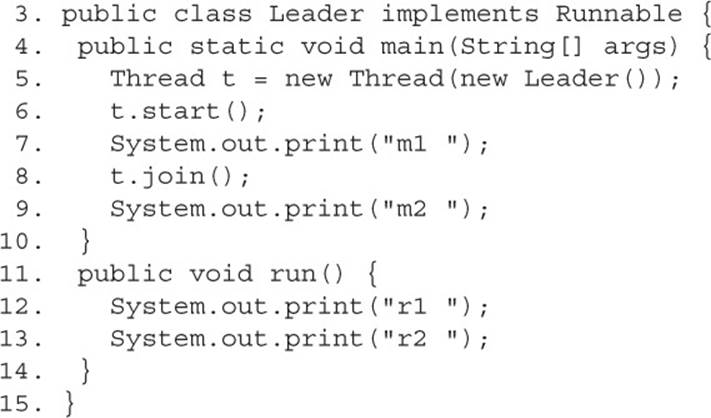
Which are true? (Choose all that apply.)
A. Compilation fails
B. The output could be r1 r2 m1 m2
C. The output could be m1 m2 r1 r2
D. The output could be m1 r1 r2 m2
E. The output could be m1 r1 m2 r2
F. An exception is thrown at runtime
15. Given:
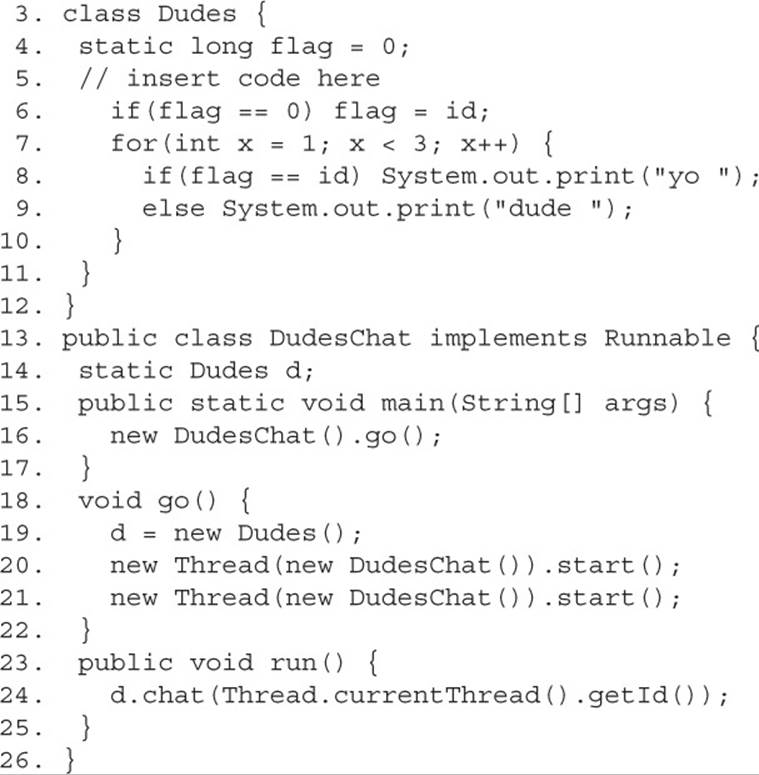
And given these two fragments:
![]()
When fragment I or fragment II is inserted at line 5, which are true? (Choose all that apply.)
A. An exception is thrown at runtime
B. With fragment I, compilation fails
C. With fragment II, compilation fails
D. With fragment I, the output could be yo dude dude yo
E. With fragment I, the output could be dude dude yo yo
F. With fragment II, the output could be yo dude dude yo
16. Given:

Which are true? (Choose all that apply.)
A. Compilation fails
B. The output could be 4 4 2 3
C. The output could be 4 4 2 2
D. The output could be 4 4 4 2
E. The output could be 2 2 4 4
F. An exception is thrown at runtime
17. Given:
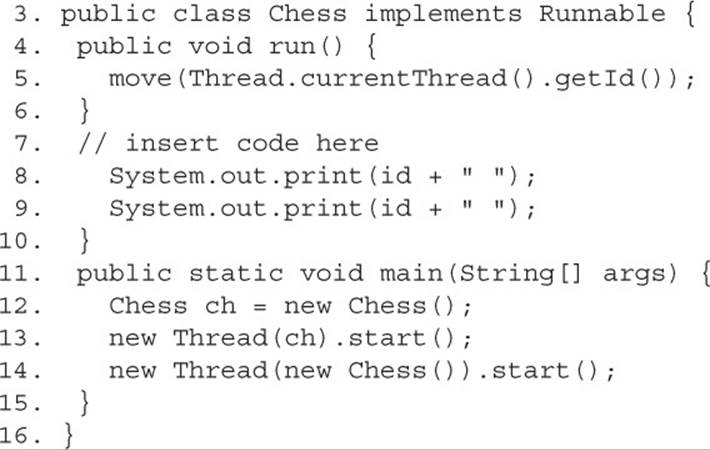
And given these two fragments:
![]()
When either fragment I or fragment II is inserted at line 7, which are true? (Choose all that apply.)
A. Compilation fails
B. With fragment I, an exception is thrown
C. With fragment I, the output could be 4 2 4 2
D. With fragment I, the output could be 4 4 2 3
E. With fragment II, the output could be 2 4 2 4
SELF TEST ANSWERS
1. ![]() C is correct. The class implements the Runnable interface with a legal run() method.
C is correct. The class implements the Runnable interface with a legal run() method.
![]() A is incorrect because interfaces are implemented, not extended. B is incorrect because even though the class has a valid public void run() method, it does not implement the Runnable interface. D is incorrect because the run() method must be public. E is incorrect because the method to implement is run(), not start(). (OCP Objective 10.1)
A is incorrect because interfaces are implemented, not extended. B is incorrect because even though the class has a valid public void run() method, it does not implement the Runnable interface. D is incorrect because the run() method must be public. E is incorrect because the method to implement is run(), not start(). (OCP Objective 10.1)
2. ![]() D is correct. The thread MyThread will start and loop three times (from 0 to 2).
D is correct. The thread MyThread will start and loop three times (from 0 to 2).
![]() A is incorrect because the Thread class implements the Runnable interface; therefore, in line 6, Thread can take an object of type Thread as an argument in the constructor (this is NOT recommended). B and C are incorrect because the variable i in the for loop starts with a value of 0 and ends with a value of 2. E is incorrect based on the above. (OCP Objective 10.1)
A is incorrect because the Thread class implements the Runnable interface; therefore, in line 6, Thread can take an object of type Thread as an argument in the constructor (this is NOT recommended). B and C are incorrect because the variable i in the for loop starts with a value of 0 and ends with a value of 2. E is incorrect based on the above. (OCP Objective 10.1)
3. ![]() D is correct. The sleep() method must be enclosed in a try/catch block, or the method printAll() must declare it throws the InterruptedException.
D is correct. The sleep() method must be enclosed in a try/catch block, or the method printAll() must declare it throws the InterruptedException.
![]() E is incorrect, but it would be correct if the InterruptedException was dealt with (A is too precise). B is incorrect (even if the InterruptedException was dealt with) because all Java code, including the main() method, runs in threads. C is incorrect. The sleep() method isstatic; it always affects the currently executing thread. (OCP Objective 10.2)
E is incorrect, but it would be correct if the InterruptedException was dealt with (A is too precise). B is incorrect (even if the InterruptedException was dealt with) because all Java code, including the main() method, runs in threads. C is incorrect. The sleep() method isstatic; it always affects the currently executing thread. (OCP Objective 10.2)
4. ![]() B and F are correct. By marking the methods as synchronized, the threads will get the lock of the this object before proceeding. Only one thread will be setting or reading at any given moment, thereby assuring that read() always returns the addition of a valid pair.
B and F are correct. By marking the methods as synchronized, the threads will get the lock of the this object before proceeding. Only one thread will be setting or reading at any given moment, thereby assuring that read() always returns the addition of a valid pair.
![]() A is incorrect because it is not synchronized; therefore, there is no guarantee that the values added by the read() method belong to the same pair. C and D are incorrect; only objects can be used to synchronize on. E is incorrect because it fails—it is not possible to select other objects (even this) to synchronize on when declaring a method as synchronized. (OCP Objectives 10.3 and 10.4)
A is incorrect because it is not synchronized; therefore, there is no guarantee that the values added by the read() method belong to the same pair. C and D are incorrect; only objects can be used to synchronize on. E is incorrect because it fails—it is not possible to select other objects (even this) to synchronize on when declaring a method as synchronized. (OCP Objectives 10.3 and 10.4)
5. ![]() D is correct. 1 and 2 will be printed, but there will be no return from the wait call because no other thread will notify the main thread, so 3 will never be printed. It’s frozen at line 7.
D is correct. 1 and 2 will be printed, but there will be no return from the wait call because no other thread will notify the main thread, so 3 will never be printed. It’s frozen at line 7.
![]() A is incorrect; IllegalMonitorStateException is an unchecked exception. B and C are incorrect; 3 will never be printed, since this program will wait forever. E is incorrect because IllegalMonitorStateException will never be thrown because the wait() is done on args within a block of code synchronized on args. F is incorrect because any object can be used to synchronize on, and this and static don’t mix. (OCP Objective 10.4)
A is incorrect; IllegalMonitorStateException is an unchecked exception. B and C are incorrect; 3 will never be printed, since this program will wait forever. E is incorrect because IllegalMonitorStateException will never be thrown because the wait() is done on args within a block of code synchronized on args. F is incorrect because any object can be used to synchronize on, and this and static don’t mix. (OCP Objective 10.4)
6. ![]() A is correct. Either of the two events will make the thread a candidate for running again.
A is correct. Either of the two events will make the thread a candidate for running again.
![]() B is incorrect because a waiting thread will not return to runnable when the lock is released unless a notification occurs. C is incorrect because the thread will become a candidate immediately after notification. D is also incorrect because a thread will not come out of a waiting pool just because a lock has been released. (OCP Objective 10.4)
B is incorrect because a waiting thread will not return to runnable when the lock is released unless a notification occurs. C is incorrect because the thread will become a candidate immediately after notification. D is also incorrect because a thread will not come out of a waiting pool just because a lock has been released. (OCP Objective 10.4)
7. ![]() A is correct because notifyAll() (and wait() and notify()) must be called from within a synchronized context. D is a correct statement.
A is correct because notifyAll() (and wait() and notify()) must be called from within a synchronized context. D is a correct statement.
![]() B is incorrect because to call wait(), the thread must own the lock on the object that wait() is being invoked on, not the other way around. C is incorrect because notify() is defined in java.lang.Object. E is incorrect because notify() will not cause a thread to release its locks. The thread can only release its locks by exiting the synchronized code. F is incorrect because notifyAll() notifies all the threads waiting on a particular locked object, not all threads waiting on any object. (OCP Objectives 10.3 and 10.4)
B is incorrect because to call wait(), the thread must own the lock on the object that wait() is being invoked on, not the other way around. C is incorrect because notify() is defined in java.lang.Object. E is incorrect because notify() will not cause a thread to release its locks. The thread can only release its locks by exiting the synchronized code. F is incorrect because notifyAll() notifies all the threads waiting on a particular locked object, not all threads waiting on any object. (OCP Objectives 10.3 and 10.4)
8. ![]() E is correct. Synchronizing the public methods is sufficient to make this safe, so F is incorrect. This class is not thread-safe unless some sort of synchronization protects the changing data.
E is correct. Synchronizing the public methods is sufficient to make this safe, so F is incorrect. This class is not thread-safe unless some sort of synchronization protects the changing data.
![]() B is incorrect because although a StringBuffer is synchronized internally, we call append() multiple times, and nothing would prevent two simultaneous log() calls from mixing up their messages. C and D are incorrect because if one method remains unsynchronized, it can run while the other is executing, which could result in reading the contents while one of the messages is incomplete, or worse. (You don’t want to call toString() on the StringBuffer as it’s resizing its internal character array.) (OCP Objective 10.3)
B is incorrect because although a StringBuffer is synchronized internally, we call append() multiple times, and nothing would prevent two simultaneous log() calls from mixing up their messages. C and D are incorrect because if one method remains unsynchronized, it can run while the other is executing, which could result in reading the contents while one of the messages is incomplete, or worse. (You don’t want to call toString() on the StringBuffer as it’s resizing its internal character array.) (OCP Objective 10.3)
9. ![]() G is correct. The code does not acquire a lock on t before calling t.wait(), so it throws an IllegalMonitorStateException. The method is synchronized, but it’s not synchronized on t so the exception will be thrown. If the wait were placed inside a synchronized(t) block, thenD would be correct.
G is correct. The code does not acquire a lock on t before calling t.wait(), so it throws an IllegalMonitorStateException. The method is synchronized, but it’s not synchronized on t so the exception will be thrown. If the wait were placed inside a synchronized(t) block, thenD would be correct.
![]() A, B, C, D, E, and F are incorrect based on the logic described above. (OCP Objective 10.2)
A, B, C, D, E, and F are incorrect based on the logic described above. (OCP Objective 10.2)
10. ![]() B is correct. In the first line of main we’re constructing an instance of an anonymous inner class extending from MyThread. So the MyThread constructor runs and prints MyThread. Next, main() invokes start() on the new thread instance, which causes the overridden run() method (the run() method in the anonymous inner class) to be invoked.
B is correct. In the first line of main we’re constructing an instance of an anonymous inner class extending from MyThread. So the MyThread constructor runs and prints MyThread. Next, main() invokes start() on the new thread instance, which causes the overridden run() method (the run() method in the anonymous inner class) to be invoked.
![]() A, C, D, E, F, G, and H are incorrect based on the logic described above. (OCP Objective 10.1)
A, C, D, E, F, G, and H are incorrect based on the logic described above. (OCP Objective 10.1)
11. ![]() A, F, and H are correct. A is correct because when synchronized instance methods are called on the same instance, they block each other. F and H can’t happen because synchronized static methods in the same class block each other, regardless of which instance was used to call the methods. (An instance is not required to call static methods; only the class.)
A, F, and H are correct. A is correct because when synchronized instance methods are called on the same instance, they block each other. F and H can’t happen because synchronized static methods in the same class block each other, regardless of which instance was used to call the methods. (An instance is not required to call static methods; only the class.)
![]() C, although incorrect, could happen because synchronized instance methods called on different instances do not block each other. B, D, E, and G are incorrect but also could all happen because instance methods and static methods lock on different objects, and do not block each other. (OCP Objectives 10.3 and 10.4)
C, although incorrect, could happen because synchronized instance methods called on different instances do not block each other. B, D, E, and G are incorrect but also could all happen because instance methods and static methods lock on different objects, and do not block each other. (OCP Objectives 10.3 and 10.4)
12. ![]() A, C, D, E, and F are correct. This may look like laurel and hardy are battling to cause the other to sleep() or wait()—but that’s not the case. Since sleep() is a static method, it affects the current thread, which is laurel (even though the method is invoked using a reference to hardy). That’s misleading, but perfectly legal, and the Thread laurel is able to sleep with no exception, printing A and C (after at least a one-second delay). Meanwhile, hardy tries to call laurel.wait()—but hardy has not synchronized on laurel, so calling laurel.wait()immediately causes an IllegalMonitorStateException, and so hardy prints D, E, and F. Although the order of the output is somewhat indeterminate (we have no way of knowing whether A is printed before D, for example), it is guaranteed that A, C, D, E, and F will all be printed in some order, eventually—so G is incorrect.
A, C, D, E, and F are correct. This may look like laurel and hardy are battling to cause the other to sleep() or wait()—but that’s not the case. Since sleep() is a static method, it affects the current thread, which is laurel (even though the method is invoked using a reference to hardy). That’s misleading, but perfectly legal, and the Thread laurel is able to sleep with no exception, printing A and C (after at least a one-second delay). Meanwhile, hardy tries to call laurel.wait()—but hardy has not synchronized on laurel, so calling laurel.wait()immediately causes an IllegalMonitorStateException, and so hardy prints D, E, and F. Although the order of the output is somewhat indeterminate (we have no way of knowing whether A is printed before D, for example), it is guaranteed that A, C, D, E, and F will all be printed in some order, eventually—so G is incorrect.
![]() B, G, and H are incorrect based on the above. (OCP Objective 10.4)
B, G, and H are incorrect based on the above. (OCP Objective 10.4)
13. ![]() C and D are correct. Fragment I doesn’t start a new thread. Fragment II doesn’t compile. Fragment III creates a new thread but doesn’t start it. Fragment IV creates a new thread and invokes run() directly, but it doesn’t start the new thread. Fragment V creates and starts a new thread.
C and D are correct. Fragment I doesn’t start a new thread. Fragment II doesn’t compile. Fragment III creates a new thread but doesn’t start it. Fragment IV creates a new thread and invokes run() directly, but it doesn’t start the new thread. Fragment V creates and starts a new thread.
![]() A, B, E, F, and G are incorrect based on the above. (OCP Objective 10.1)
A, B, E, F, and G are incorrect based on the above. (OCP Objective 10.1)
14. ![]() A is correct. The join() must be placed in a try/catch block. If it were, answers B and D would be correct. The join() causes the main thread to pause and join the end of the other thread, meaning “m2” must come last.
A is correct. The join() must be placed in a try/catch block. If it were, answers B and D would be correct. The join() causes the main thread to pause and join the end of the other thread, meaning “m2” must come last.
![]() B, C, D, E, and F are incorrect based on the above. (OCP Objective 10.2)
B, C, D, E, and F are incorrect based on the above. (OCP Objective 10.2)
15. ![]() F is correct. With Fragment I, the chat method is synchronized, so the two threads can’t swap back and forth. With either fragment, the first output must be yo.
F is correct. With Fragment I, the chat method is synchronized, so the two threads can’t swap back and forth. With either fragment, the first output must be yo.
![]() A, B, C, D, and E are incorrect based on the above. (OCP Objective 10.3)
A, B, C, D, and E are incorrect based on the above. (OCP Objective 10.3)
16. ![]() F is correct. When run() is invoked, it is with a new instance of ChicksYack and c has not been assigned to an object. If c were static, then because yack is synchronized, answers C and E would have been correct.
F is correct. When run() is invoked, it is with a new instance of ChicksYack and c has not been assigned to an object. If c were static, then because yack is synchronized, answers C and E would have been correct.
![]() A, B, C, D, and E are incorrect based on the above. (OCP Objectives 10.1 and 10.3)
A, B, C, D, and E are incorrect based on the above. (OCP Objectives 10.1 and 10.3)
17. ![]() C and E are correct. E should be obvious. C is correct because even though move() is synchronized, it’s being invoked on two different objects.
C and E are correct. E should be obvious. C is correct because even though move() is synchronized, it’s being invoked on two different objects.
![]() A, B, and D are incorrect based on the above. (OCP Objective 10.3)
A, B, and D are incorrect based on the above. (OCP Objective 10.3)
EXERCISE ANSWERS
Exercise 13-1: Creating a Thread and Putting It to Sleep
The final code should look something like this:
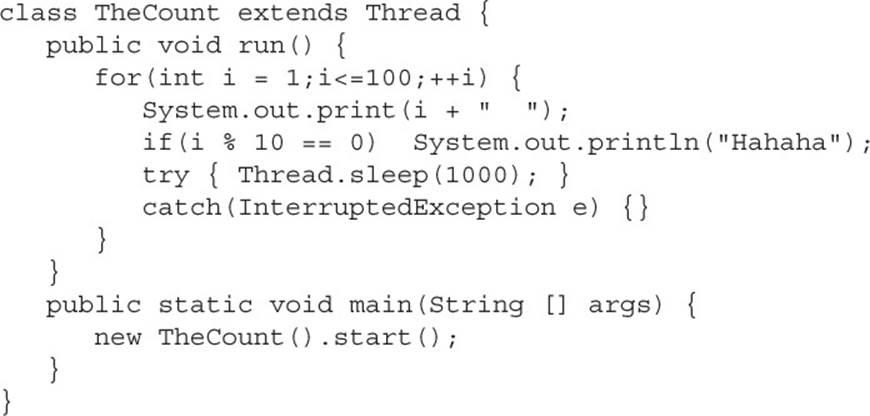
Exercise 13-2: Synchronizing a Block of Code
Your code might look something like this when completed:
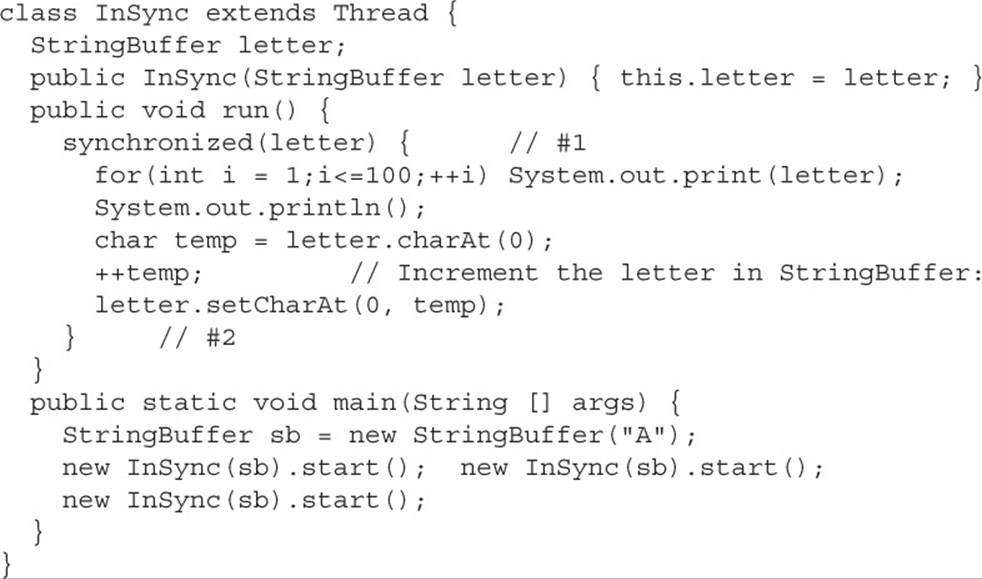
Just for fun, try removing lines 1 and 2 and then run the program again. It will be unsynchronized—watch what happens.
All materials on the site are licensed Creative Commons Attribution-Sharealike 3.0 Unported CC BY-SA 3.0 & GNU Free Documentation License (GFDL)
If you are the copyright holder of any material contained on our site and intend to remove it, please contact our site administrator for approval.
© 2016-2025 All site design rights belong to S.Y.A.